Home » Posts tagged 'tesla'
Tag Archives: tesla
Electric Vehicles 101: 2024 EV Buyers’ and Owners’ Guide
We’ve put this Electric Vehicle Guide together for those just getting their feet wet in the EV world. But we think you’ll find a few golden nuggets even if you’re a die hard EV owner like us. Our EV adventure began in 2016 with the purchase of a Tesla Model S with Full Self-Driving (FSD) after Elon Musk’s video was released showing his Tesla driving him to work hands-free and dropping him off at the front door of the office building before parking itself after waiting for pedestrians to cross the street. All fabrications as we would later learn. When our car unexpectedly died in the middle of nowhere leaving us stranded 200 miles from the nearest Tesla dealer, we sold it.
Lesson #1: Never buy any car that you can’t get fixed in a timely manner by a repair shop near where you live and/or frequently travel.
Following our Tesla debacle, we purchased a Jaguar I-Pace followed by a Tesla Model X, then a Kia EV6 and last week a Mustang Mach-E GT, Performance Edition. So we’ve been around the block (several times).
In our 7+ years of EV ownership, here are our take-aways.
Lesson #2: If you’re dead set on owning a Tesla, DO NOT PURCHASE FULL SELF-DRIVING. It was promised in 2016 and every year since. It’s not even close to working safely and reliably. In fact, I’m amazed it is still allowed on public streets. If you really want full self-driving, buy a GM product with Super Cruise or a Ford product with Blue Cruise. Both work flawlessly.
Lesson #3: Unless you have a way to charge your vehicle regularly at your home, don’t buy an EV. If you really still want to be part of the EV revolution, buy a hybrid (PHEV) that can keep itself charged. Using public charging facilities to keep your vehicle charged is not only time-consuming, but it’s also expensive. Pricing at most public EV chargers is almost as costly as gasoline, and a fill-up typically takes 40 to 60 minutes as opposed to 5 minutes at a gas pump.
Lesson #4: Avoid long road trips in an EV. It’s nerve-wracking, expensive, and time-consuming. A neighbor of ours in Florida drives his EV from Washington, D.C. to the beach and has to make five or six charging stops along the way. I’d sooner shoot myself. If you’re fortunate enough to be able to afford a second car, an EV makes an excellent, cost-saving, around-town car especially if you can charge it in your garage. For example, in Florida, charging in your garage costs roughly 5 cents per mile of charge. That’s less than one-third the cost of driving a typical gas-powered vehicle.
Lesson #5: We would never own another vehicle without Lane Keeping Assist (LKA), Elon calls it Auto-Pilot on the Tesla. It’s available on virtually every modern vehicle for an extra charge. While it won’t drive you to your destination and still requires that you keep your hands on the wheel, the stress of driving is greatly reduced. Be advised that all LKA systems are not created equal. On a Tesla, the feature is an all or nothing deal. You cannot make minor steering corrections without first disengaging auto-pilot by yanking on the steering wheel. With the other vehicles we’ve owned including Audi, Nissan, Infiniti, Jaguar, Range Rover, and Mustang, you can make steering adjustments without disengaging LKA, a much safer approach.
Charging Your Electric Vehicle
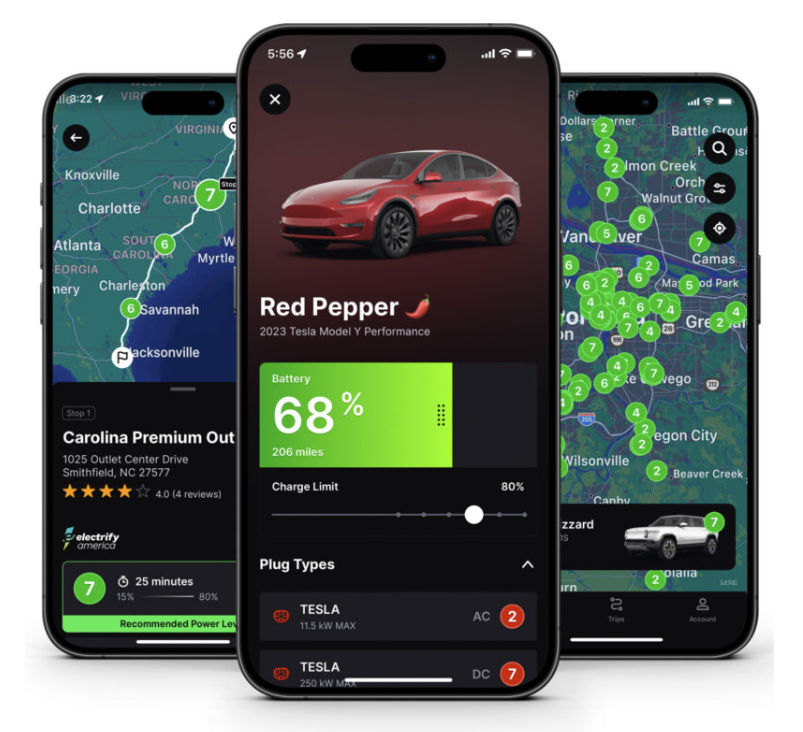
There are three types of charging systems for EVs: Level 1, 2, and 3. Level 1 chargers can be used with any 120 volt, 20 amp A/C outlet and provide about 3-5 miles of charge for every hour of connection. Level 2 chargers are typically installed in garages or office building. They require a 240 volt, 50 or 60 amp connection and provide 20 to 25 miles of charge per hour. Level 3 chargers are expensive and are typically found at commercial charging stations such as Tesla Superchargers, Electrify America, EVgo, and many others. They can provide 50 to several hundred miles of charge per hour. Prices vary depending upon local costs of electricity as well as supply and demand. The two questions you should be asking are (1) where’s the nearest Level 3 charger to my current location when I have 20% of range left and (2) which chargers have the best pricing per kWh. Our favorite cellphone app to obtain this information is Chargeway. It can be configured to show Tesla Superchargers or CCS chargers or both with pricing and charge availability. Chargeway includes over 80,000 charging stations from over 40 networks throughout the US and Canada. Add your EV and it automatically shows stations that match your EV’s plug type and power levels as well as pricing and charge time estimates. Once you’ve identified your vehicle in the app, you can further refine the settings in the Filters option. We typically set Green (J1772/CCS) to 6 and 7, Blue (CHadeMO) to 7, and Red (Tesla/NACS) to 7 since Mustangs can use both CCS and Tesla V3+ Superchargers (with adapter).
Finding Information About Electric Vehicles
Our favorite source of news about EVs is Electrek.While the editor was originally a Tesla FanBoy, he has sobered up a bit since his Tesla tried to kill him a couple times. Another great source of information are the forums for Tesla, Rivian, and the Mach-E.
Current Deals on Electric Vehicles
Before you start shopping for an EV, you first may wish consider which electric vehicles current;y qualify for tax rebates. Also worth a careful review are which vehicles include free charging. Finally, it’s a good idea to check recent news articles documenting price reductions on particular EVs. For example, just last week Ford dramatically cut the prices on all 2023 Mach-E vehicles and brought back 0% financing. If you’re dead set on a Tesla, the best time to purchase is the last week of every quarter when Tesla is attempting to meet sales goals.
Something We’ve Missed?
If you’ve got a tip that we’ve overlooked, feel free to share it by leaving a comment below.
The $10,000 Hoax: Meet Tesla’s Full Self-Driving Vehicle
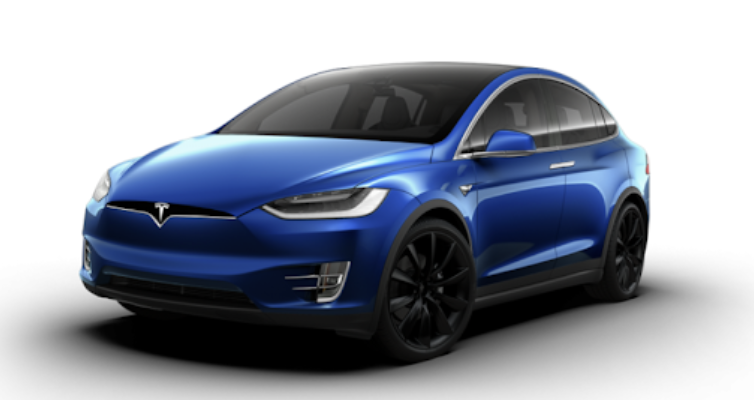
Elon Musk has called Tesla’s pricey $10,000 full self-driving option "amazing by most standards, but we are aiming for 1000% safer than the average human driver,” Here’s our take after 10 minutes behind the wheel with Tesla’s tenth FSD beta release. We’ll all be dead before Elon ever achieves that goal. And, unless you’ve chosen today as your last day above ground on Planet Earth, turn this "feature" off and leave it that way. Better yet, don’t buy it.
To give you some idea of the functionality, take a toddler out to the farm and put them on a tractor alone pointed to the nearby barn. Then put the tractor in gear and tell the toddler you’ll meet them at the barn, but you prefer to walk. Odds are you’ll get there first. But you may never see the toddler alive again. One thing’s for certain with FSD, Tesla won’t have to nag you to keep your hands on the steering wheel. You’ll be holding on for dear life!
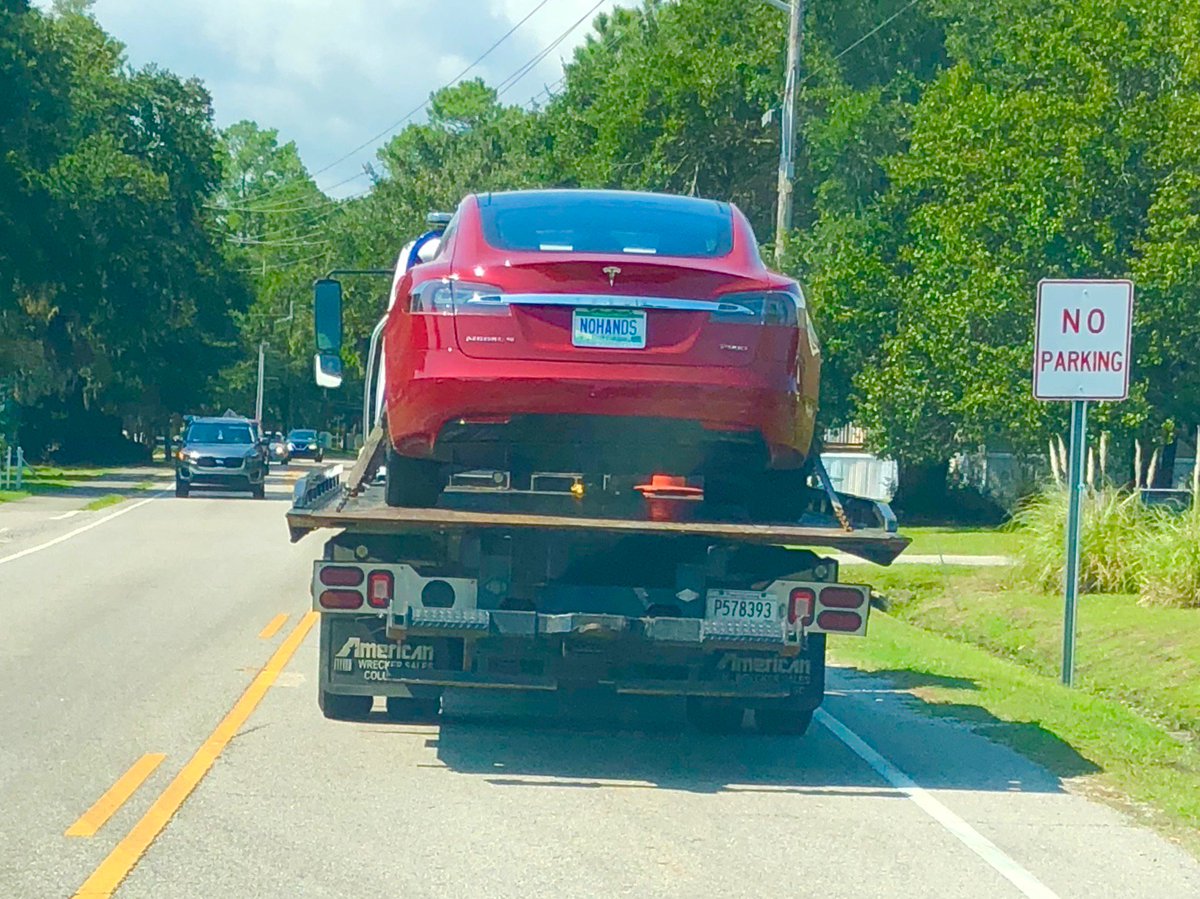
We’ve managed to keep our sense of humor about all of this for a couple of reasons. First, we’ve been gobbling up Elon’s bullshit for almost five years, and we’re on our second Tesla with Full Self-Driving. If you’ve read our previous Tesla articles, you already know that our first Model S departed on a tow truck. But, you know what they say about pioneers loving the arrows in the back. It wasn’t long until we bought a Model X with Full Self-Driving after a two year stint with a Jaguar I-Pace. Well, we’ve had the Model X almost two years and still no FSD. So we decided to trade it for a more comfortable car, and we’ve been awaiting the arrival of an Audi Q8 which we’ll enjoy until the Cadillac LYRIQ with SuperCruise becomes available.
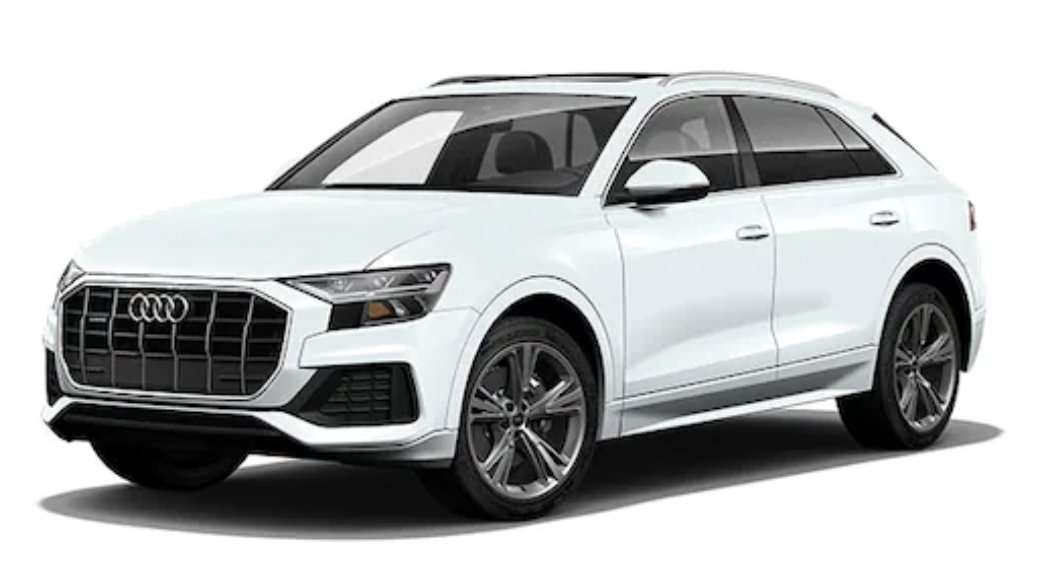
Lo and behold, the day before the Q8 was scheduled to arrive, the magic light went on signaling the arrival of FSD on our Model X. All of a sudden we had the best of both worlds, a new car with no deposit arriving tomorrow and the chance to try out FSD to see if we’d prefer to keep the Tesla. We thought it would be a difficult decision considering all the hoopla (a polite word) surrounding FSD. It wasn’t. We took the Tesla a couple miles from home on well-marked roads and told the car to take us home. Disengagement is a word Tesla uses to describe a situation in which the autopilot software fails and the driver needs to take control of the car. The number of FSD disengagements returning home must have set a record. I lost count at a dozen. The simplest maneuvers such as avoiding a trash can on the curb of the road or making a turn into a street with two incoming lanes were met with alarming machinations not unlike the toddler driving the tractor. Could we have made it home alive? We weren’t sure. Nor were we brave (or patient) enough to find out.
https://youtu.be/o7oZ-AQszEI
We’re recounting this fiasco to warn you of the dangers of using FSD. It also makes us wonder how federal, state, and local authorities have ever allowed Elon’s science experiment on public roads. It really is that dangerous. And finally, we wanted to save you $10,000 should you decide to buy a Tesla. There’s a reason you won’t find FSD on demo vehicles at Tesla showrooms. And that should tell you everything you need to know.
Originally published: Wednesday, December 1, 2021
Review: The 2021 Cadillac Escalade – Everything a Tesla Isn’t
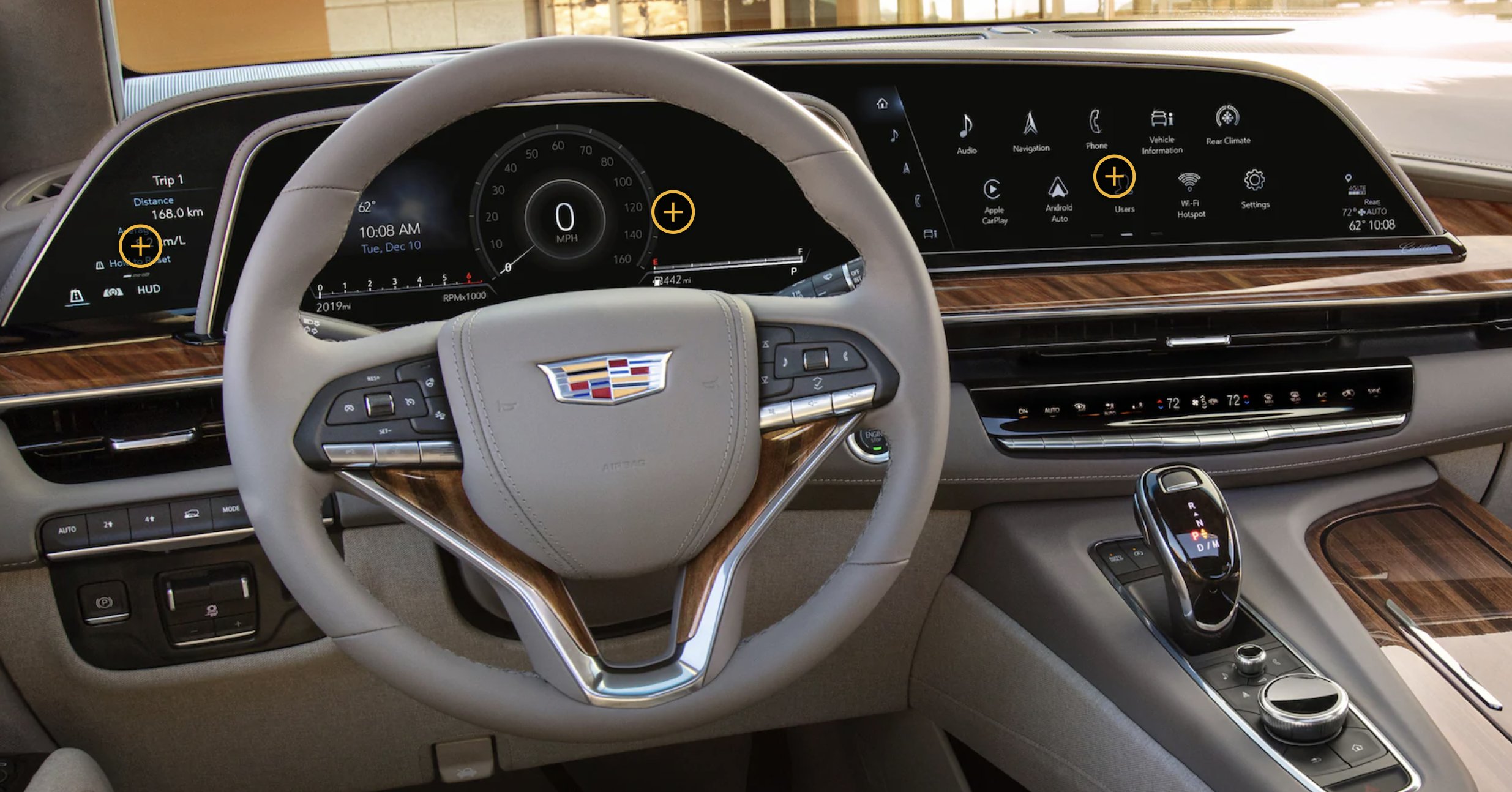
Happy Valentine’s Day. We’re on our fifth year of our love-hate relationship with Elon and Tesla. After a second purchase of a Tesla with Full Self-Driving (FSD) and no cigar, it’s beginning to smell more like vaporware. Tesla now is morphing FSD into a "feature set" that includes Automatic Lane Changes, Summon from across the garage, AutoPark (maybe and sometimes), Traffic and Stop Sign Alerts, and AutoSteer on City Streets (coming soon). You’ll note that AutoSteer on the highways and interstates now has vanished even though Elon touted sleeping in the back seat while his Tesla drove him from California to New York. To juice end-of-year sales, Tesla even offered buyers a 90-day FSD subscription rather than making buyers fork over $10,000 for vaporware. In case you’re confused by Tesla’s new nomenclature, keep in mind that many vehicles have had most of these "FSD features" for years, but nobody else called it full self-driving much less charging $10,000 for it.
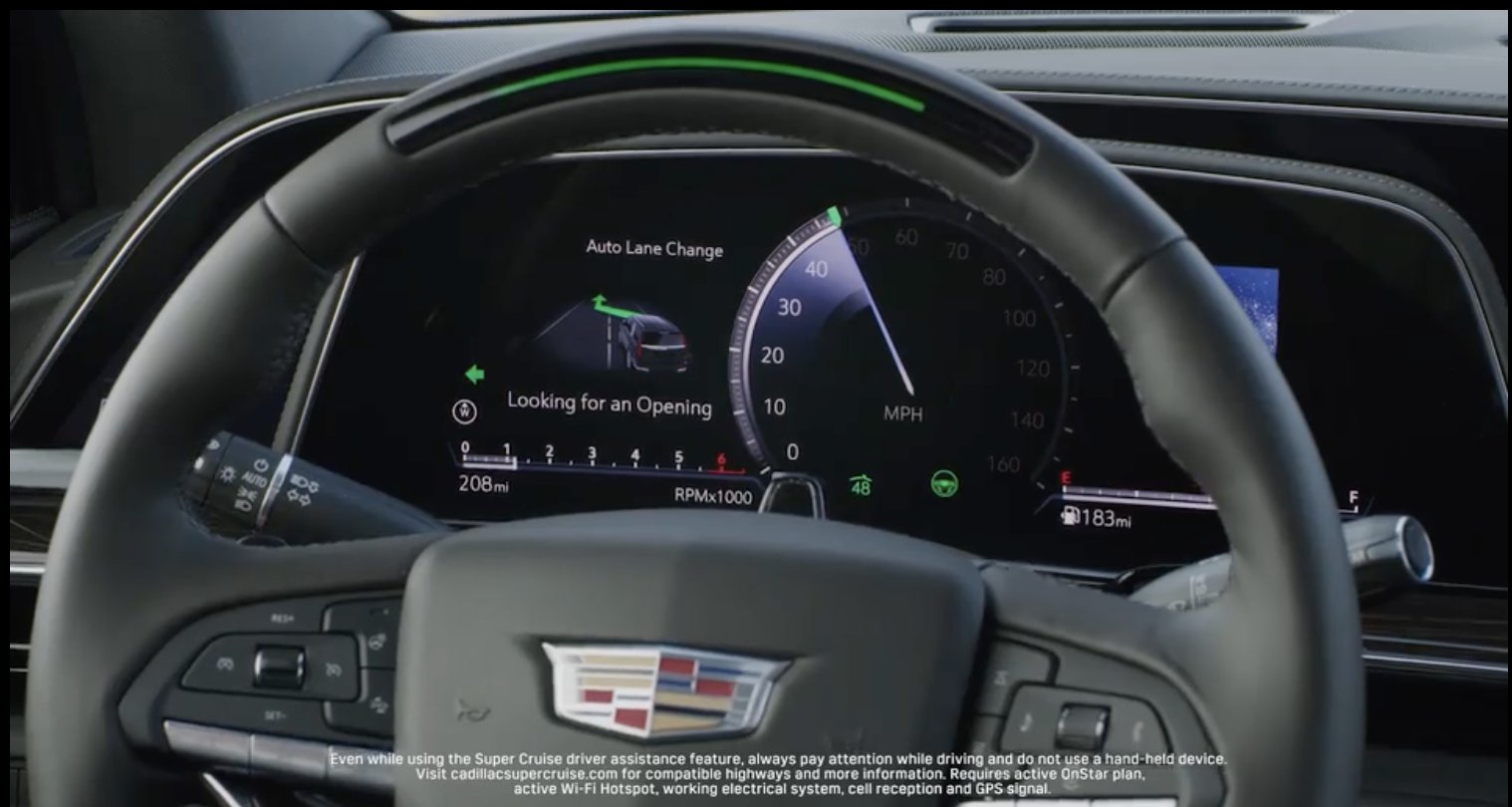
Which brings us to General Motors and the 2021 Cadillac Escalade with SuperCruise for an extra $2,500. Guess what? On all major highways in the United States, it offers hands-free Full Self-Driving so long as you sit in the driver’s seat and keep your eyes on the road. Does it park itself? Yes. Does it have Automatic Lane Change? Yes. Does it have a HUD display? Yes. Does it have Night Vision? Yes. Does the dashboard look like a glorified golf cart? No. In fact, the dashboard sports curved OLED displays measuring more than three feet in total width. Any commercial airline pilot will be drooling. Can it really drive itself without your touching the steering wheel? Absolutely. Is it perfect? Damn near. Will you ever buy a Tesla again? Probably not. This is especially true considering GM’s new electric Hummer EV is just around the corner and will also include SuperCruise.
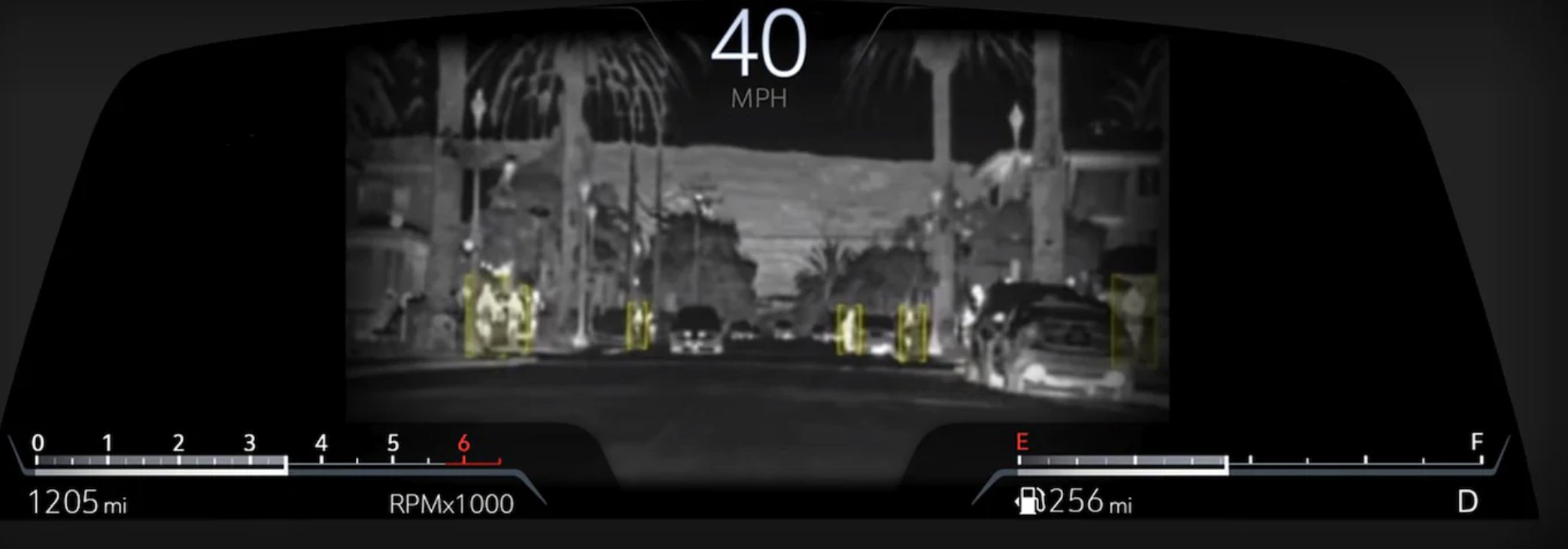
Want to know more? Well, here you go. There’s a vertical wireless charging holster between the seats that works great with an iPhone or an Android phone. Apple CarPlay and Android Auto work perfectly without ever plugging in a cable. The Escalade dash now offers lots of apps and automatic updates. Welcome, Alexa. You now can say, "Open the Garage", or "Lock the Front Door", or "Turn on the Living Room Lights" from the comfort of your car. And our old favorite, Waze, works great to alert you to every speed trap on the road. Got a favorite radio station in a distant city? The Escalade has you covered with TuneIn. And Spotify and Pandora are as close as your dashboard. Every car these days has a backup camera. The Escalade has cameras everywhere, and you can view any of them from your dashboard. There’s even a zoom in and zoom out feature. The car has its own WiFi HotSpot, or you can connect to the Internet via a Personal Hotspot on your smartphone. And, yes, the car slams on its brakes before you hit something or someone in front of or behind your vehicle.
https://youtu.be/MDTmNBGvcUY
Finally, a word about Escalade fuel costs compared to Tesla Superchargers. If you’re planning to buy a Tesla to save money on fuel costs, DON’T. Back in 2016, Tesla touted that its superchargers would "never be a profit center." This may be Tesla’s biggest scam of all. Florida has some of the least expensive electricity rates in the U.S. Yet when you use a Supercharger in Florida, the cost is nearly 8 cents a mile. But that’s a mile according to the Tesla dashboard. Just because a Tesla shows 320 miles of range, don’t believe it. 320 miles of charge actually gets you about 240 miles of driving range at typical interstate highway speeds. When you factor that into the actual cost per mile, the number is closer to 11 cents a mile. For a vehicle such as an Escalade which can use regular fuel and still get 20 miles per gallon even by the EPA highway estimate, that translates into an almost identical cost per mile. Florida regular gas is selling for about $2.20 per gallon. While an Escalade is anything but fuel efficient, your actual cost per mile is nearly the same as driving a Tesla Model X using Tesla’s Superchargers for electricity. Funny how Big Oil has managed to make gazillions of dollars off gasoline sales charging the same prices as Elon’s "non-profit" superchargers.
For those that are wondering, would we buy the new Escalade? Absolutely. In fact, we already have. Put this car on your Bucket List. Or surprise your Valentine. It’s that good.
UPDATE: And now there’s this:
Originally published: Sunday, February 14, 2021 Updated: Wednesday, April 14, 2021
2019 Technology RoundUp: What’s Hot and What’s Not
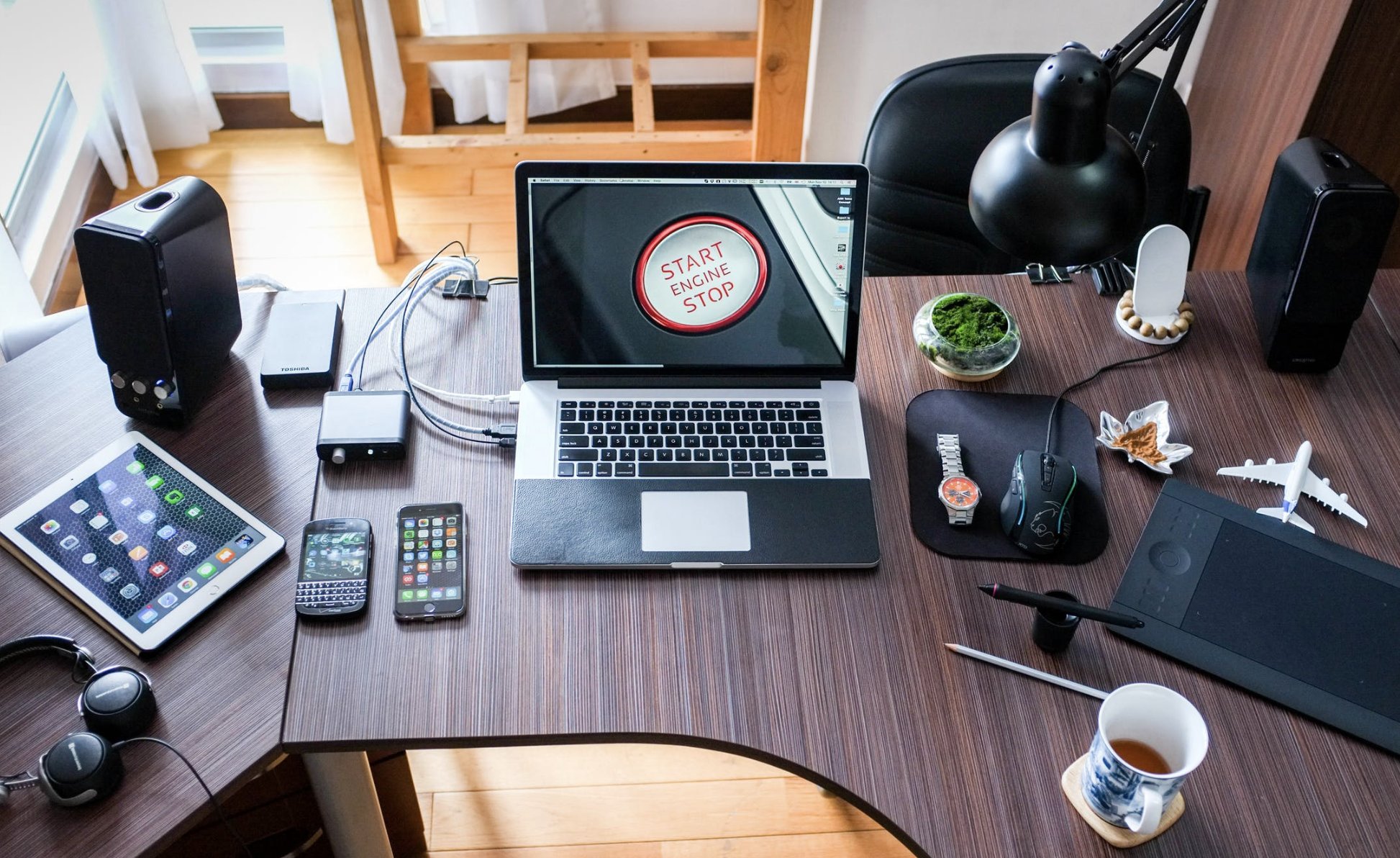
As 2019 comes to a close, we wanted to pause briefly and share some of our discoveries from this past year on all things tech. More specifically, let’s chat about solar, electric vehicles, cutting the cord from cable TV, streaming services including music and video, and cellphone data plans. We hope some of you will chime in and share your own discoveries from 2019. We’ll also apologize in advance if some of this discussion is U.S.-centric. It just happens to be our home turf.
What Are You Waiting For: GO SOLAR!
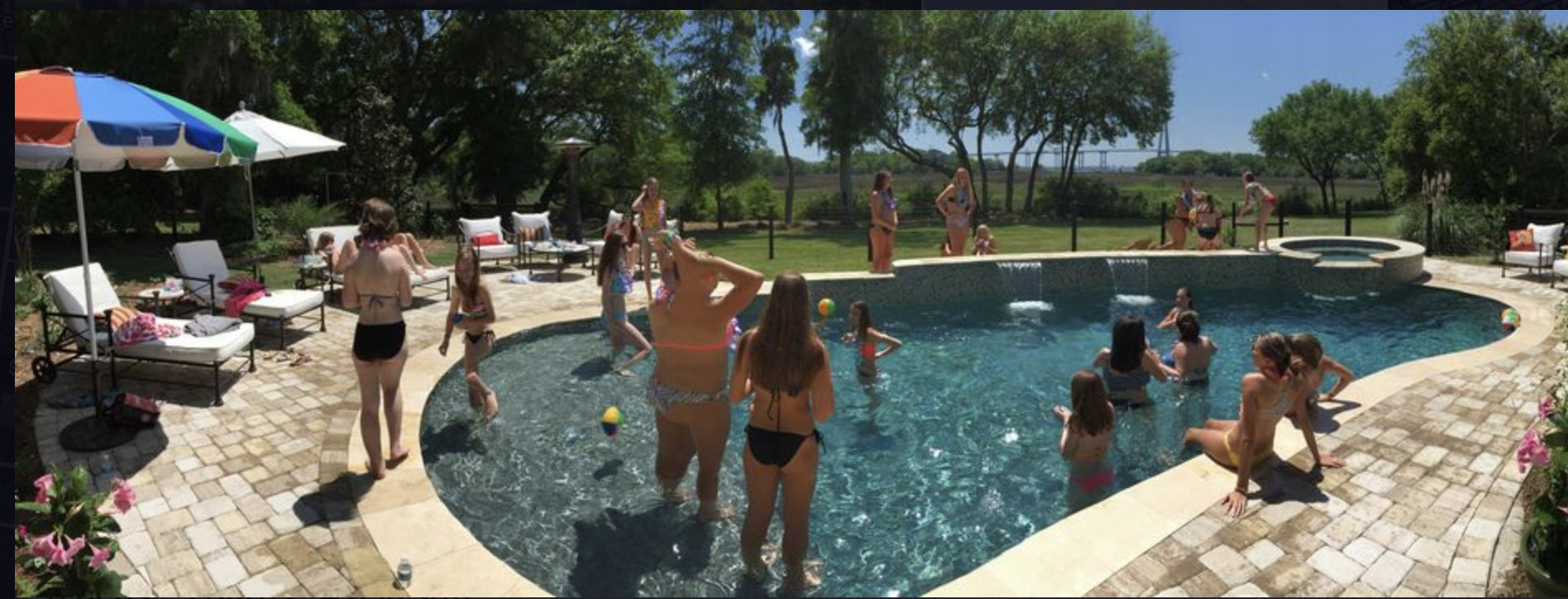
Let me begin by noting that the average electric bill on our 4,000+ square foot home with four heat pumps, two electric water heaters, and three pool pumps typically ran $500 a month prior to 2018. After installation of 50 solar panels on our roof, our average electric bill for the first six months of 2019 was about $10 a month. Installation cost of the system was about $60,000, but there was a 30% tax credit from the feds and a 25% tax credit (spread over six years) from South Carolina which reduced the actual out-of-pocket cost to about $30,000.
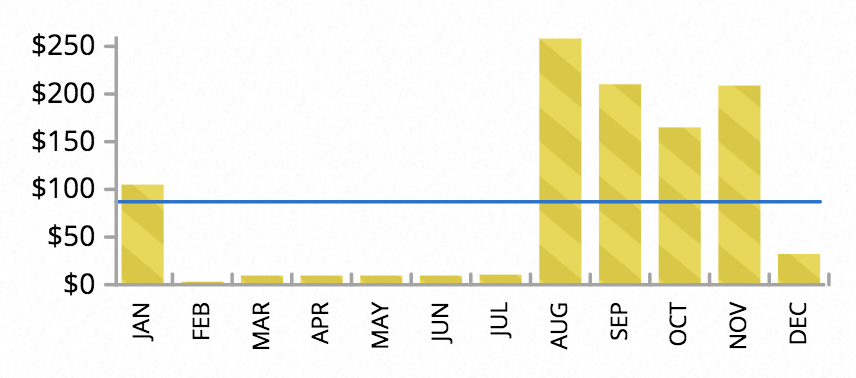
If you’re new to solar, be advised that most states have given utility companies a monopoly on electricity which means your local energy company makes the rules on how many solar panels you can install and remain connected to the grid. In the case of South Carolina, you cannot generate more electricity than you actually use in a year, but, for energy you generate, the South Carolina model is they pay you the same rate they charge for electricity. Given our current annual cost of $1,000 versus $6,000 in the good old days, our best estimate is the break-even date will be about six years from installation date. After that, it’s a $5,000 a year gravy train with solar. Coupling these utility savings with a nearly 70% reduction in our property taxes moving from Atlanta, Georgia to Charleston, we can no longer afford to move despite the fact that a few South Carolina residents still are fighting the Civil War.
What Are You Waiting For: GO ELECTRIC!

Some of you may have followed our love-hate relationship with Tesla during 2017 and 2018. Sorry to say that Elon Musk is his own worst enemy when it comes to promising far more than he can actually deliver. As much as we loved Tesla, we parted ways when a sloppy repair job totally crippled the car in the middle of nowhere leaving us hanging for over a month while Tesla attempted to diagnose the cause. It turned out they had bent a pin in replacing the big screen in the car, and it shorted out almost every function in the vehicle. The lack of a local service center coupled with the obvious shortcomings in diagnosing a system fault in the vehicle caused us to move on. HINT: Don’t fly to Mars with Elon. Tesla never came close on Elon’s full self-driving (FSD), and they still appear to be years away. We’ve joined the lawsuit to recover our FSD purchase. That and $5 will get you a cup of coffee at Starbucks.
Despite Tesla’s shortcomings, we didn’t give up on electric vehicles and purchased the First Edition of Jaguar’s I-Pace. What a difference a quality interior makes! The I-Pace is fairly comparable to the Tesla Model S in price, performance, and range. While not as refined as Tesla’s current AutoPilot, Jaguar’s Lane Keeping Assist is extremely reliable in highway driving and more than adequate on well-marked roads in town. Our only real complaint is the lack of a charging network comparable to Tesla’s in the southeastern United States. But Volkswagen’s new Electrify America coupled with ChargePoint looks promising for 2020.
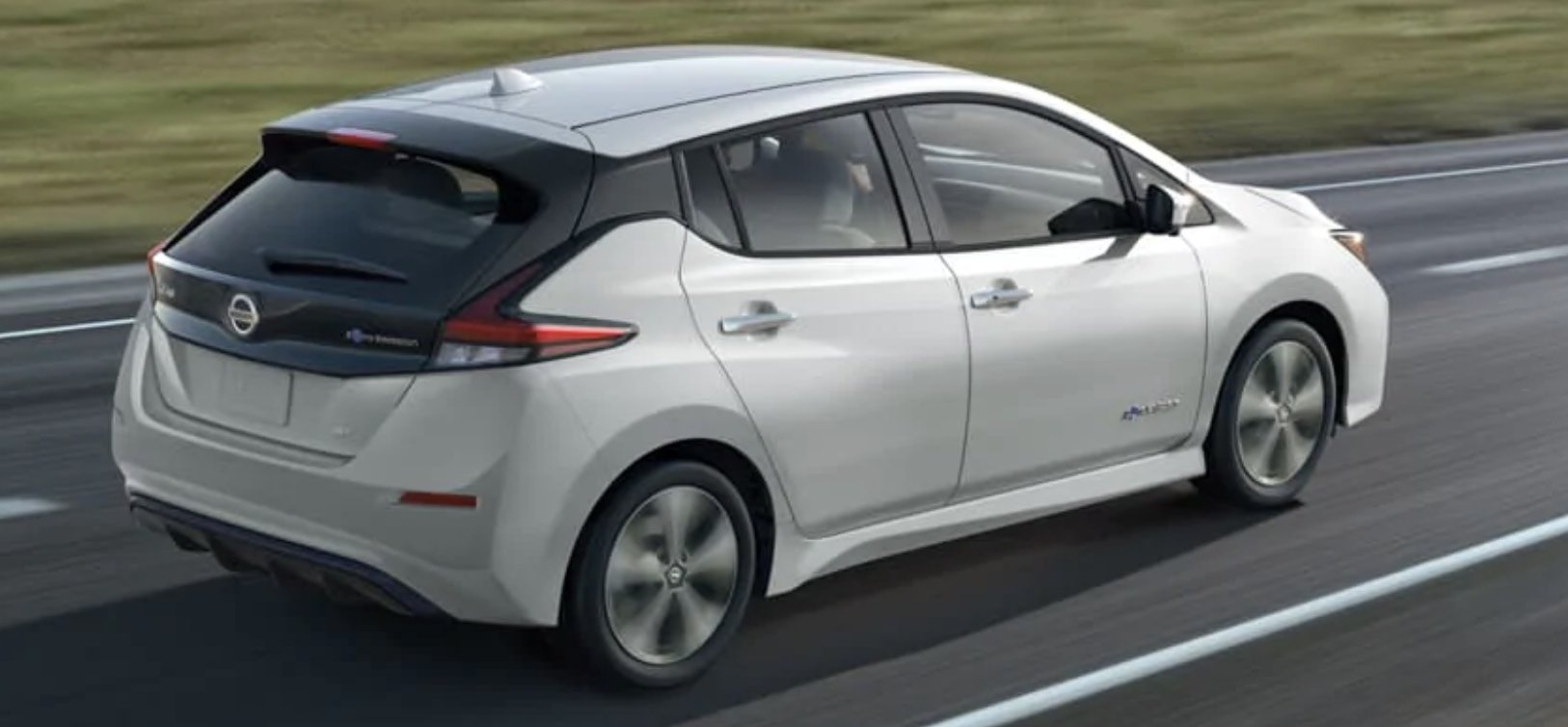
If you’re not a car nut (like us) and just want reliable transportation at a reasonable cost to get back and forth to work and for around-town driving, an electric vehicle will save you a lot of money. You really can’t beat a Nissan Leaf for about $30,000. For a few cents more, you can extend the range to over 200 miles, and you can add Lane Keeping Assist that is almost as good as a Tesla. Add a 240v NEMA 1450 outlet in your garage for about $500, and you can add about 20 miles of range for every hour of charge at a fraction of the cost of gasoline. You also can get the car serviced at any local Nissan dealership, and most also provide free charging. 50 kWh commercial DC quick chargers can provide an 80% charge in less than an hour.
What Are You Waiting For: CUT THE CORD!
Comcast reportedly lost a quarter million TV subscribers in both Q2 and Q3 of 2019. AT&T has lost five million subscribers to DirecTV and U-Verse since 2016. Price gouging finally has led millions of cable and satellite TV subscribers to cut the cord and say enough is enough. If you haven’t tried the 2019 edition of yesteryear’s TV rabbit ears and you live in an area with local TV stations within a 50-75 mile radius of your home, you’re in for quite a surprise. Over-the-air (OTA) HDTV broadcasts now are actually comparable or better than Comcast and DirecTV.
Did we mention all over-the-air HDTV broadcasts are free?
Choosing an HDTV Antenna. As you might have guessed, antennas come in all shapes and sizes. An outside antenna is light-years better than any indoor model but, if you live in an apartment where an outside antenna isn’t feasible, then visit your local WalMart and purchase three or four inside HDTV antennas of various shapes and sizes including some HDTV rabbit ears. Bring them all home and try the various antennas with a TV to see which provides the best reception and most stations. Take the others back for a refund. In almost all cases, we’ve found the HDTV rabbit ears (under $10) work as well as the more expensive models which can range in price between $8 and $50. Our favorite outdoor antenna is the Clearstream 4 for under $100 from WalMart. Old-timers will be pleased to know that the days of snowy pictures and ghost images are a thing of the past with HDTV.
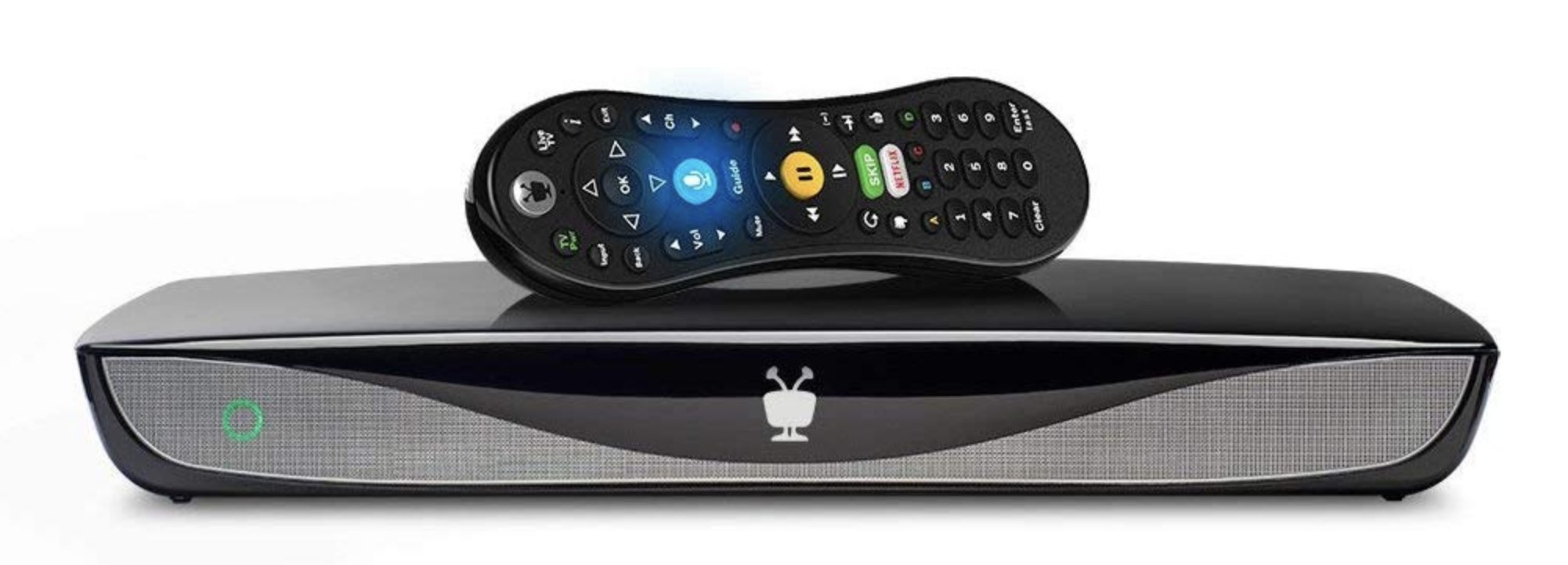
Recording Shows. If all you care about is watching local TV stations (commercials and all), then you can stop reading here. But if you like time shifting and skipping commercials, then a TiVo OTA DVR is the best game in town. TiVo is proud of their service and loves to charge a $15 monthly fee for access on top of the $200+ cost of the device. But our favorite is a $350 refurbished TiVo Roamio from Amazon that includes a lifetime subscription at no additional cost. If you’re worried about the reliability of a refurbished product, you can buy the Amazon 3-year protection plan for $33.99. We did. Once you use a TiVo unit with automatic skipping of commercials, you’ll rarely watch live TV broadcasts again. It’s that good.
Streaming TiVo Content to Other Devices. One nifty addition for your TiVO OTA unit is the ability to stream the content to devices other than the TV to which the TiVo unit is connected. The trick is to find a TiVo Stream device (about $150). It requires a wired Internet connection on the same subnet as your wired TiVo Roamio OTA unit. Once you have the unit in hand, contact TiVo with the serial number of your TiVo stream unit, and they will activate it. You then can stream any of your TiVo live or recorded content to up to four iPhones, iPads, and Android devices simultaneously. The streaming works on both your local WiFi network as well as any remote location using either WiFi or cellular service. Very slick!
Alternative Streaming Options. Another streaming alternative worth considering is TabloTV. The units start at $150 and are available at WalMart, Best Buy, and Amazon. You then add your own USB storage device and antenna. Finally, you need a subscription for the TabloTV Guide. The lifetime subscription is $150. The device can stream to computers using a web browser, iOS and Android phones and tablets as well as Roku devices and TVs. Our results with TabloTV have been hit and miss. On the same network as our TiVo machine, the TabloTV WiFi streams regularly experience pauses and drop-outs while the TiVo streams rarely do. Whether you choose a TabloTV or not, be sure to sign up for email delivery of their newsletter. It’s by far the best in the cut-the-cord industry.
Supplementing Local Content. Cut-the-cord commercial streaming services are booming as you might imagine. These services provide streaming content of what was traditional cable TV programming including local and cable news channels, sports channels, and commercial add-ons such as HBO and ShowTime. These streaming services typically support web access via a browser as well as iOS, Android, and Roku devices and smart TVs. Our current favorite is YouTube TV which offers 70+ channels for $50 a month with a free trial. Assuming you have a decent Internet connection, you’ll never return to Comcast or DirecTV after YouTube TV.
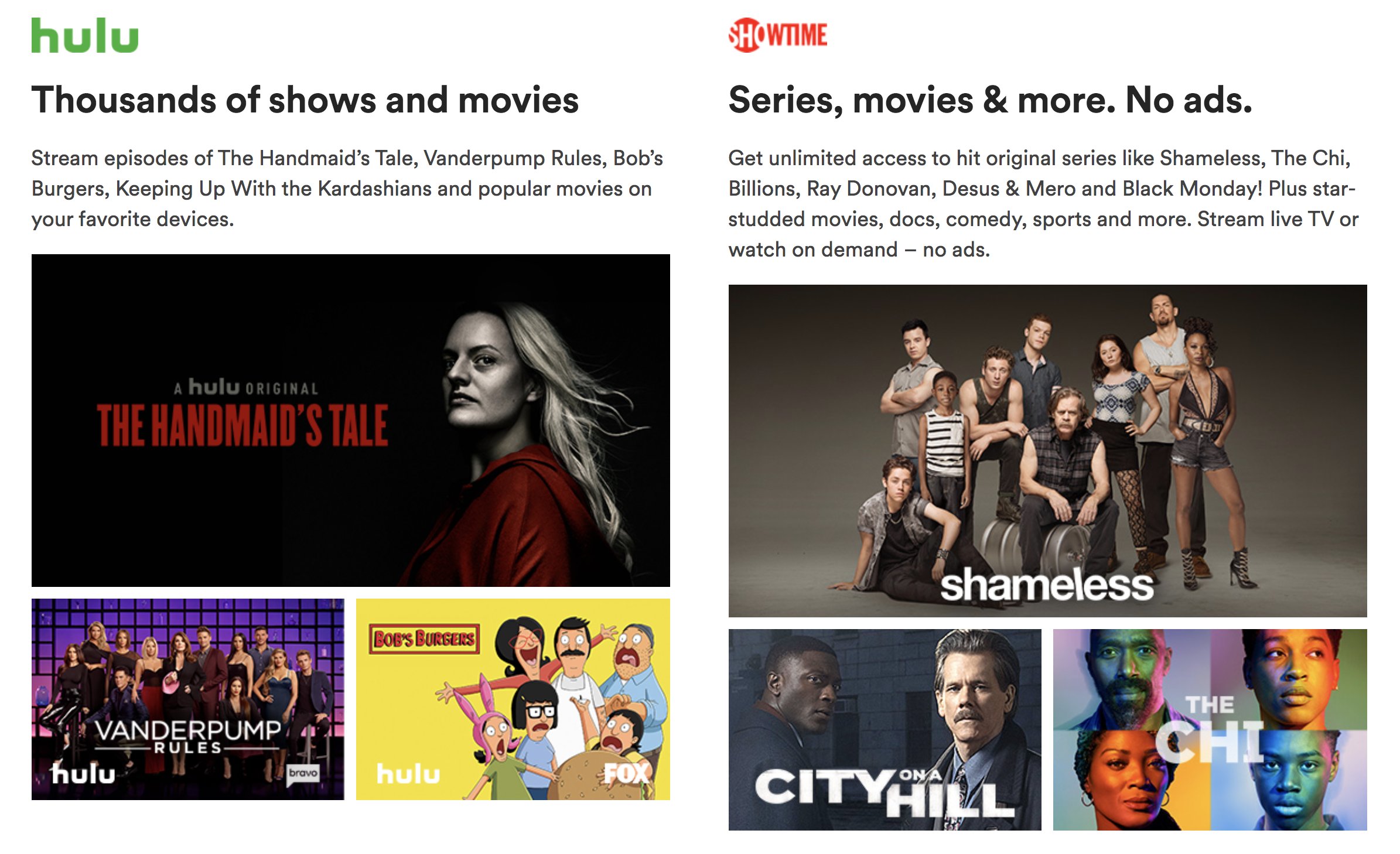
Got a Kid in College? Paying college tuition and expenses is one of the most painful periods for many families, but there’s a silver lining. Your student qualifies for unlimited music streaming plus a Hulu subscription plus a ShowTime subscription, and you get all three for only $5 a month by setting up a student Spotify account. Your first 3 months are free, and it’s renewable for up to 4 years. There’s more good news. Parents can share the credentials in a different location because the hours of your listening and viewing will rarely, if ever, coincide with those of your college son or daughter.
The Granddaddy of Streaming.Services If you only can choose one, the streaming service that most folks probably will not want to live without is Netflix. Your first 30 days are free, and plans start at $8.99 a month. That gets you one simultaneous, non-HD stream to a device of your choice. You can move up to HD streaming for $12.99 for a single stream or $14.99 for simultaneous streams to four devices. Smart TVs, computers, tablets, phones, and Roku devices are all supported. If you happen to have rental property, next to WiFi, Netflix always ranks at the top of the list of most requested amenities.
Our Must-Have Traveling Companion. The Roku Streaming Stick+ may just be the best under $50 purchase you ever make. Whether you travel or just have older not-so-smart televisions at home, so long as you have access to an HDMI port, all of your streaming services are just a click away on any TV. The only setup required when you reach your destination is plugging in your WiFi credentials. Then Netflix, Hulu, ShowTime, Comcast, Spectrum, and TabloTV immediately come to life.
Best Cellphone Plan on the Planet. If T-Mobile is supported in your neck of the woods, you won’t want to miss MintMobile, the best cellphone plan on the planet. You always get unlimited U.S. calling and messaging, and then you can choose the amount of monthly 4G LTE data you need. For the first three months, you get 12GB of monthly 4G LTE data for only $15 a month. After that, you can sign up for an annual plan at their standard 3-month rates: $15 a month for 3GB, $20 a month for 8GB, or $25 a month for 12GB. It’s an unbelievable deal compared to the Bell Sisters. Use our signup link to share the wealth with the Nerd Vittles staff. Merry Christmas to all.
Originally published: Monday, December 23, 2019
Special Thanks to Our Generous Sponsors
FULL DISCLOSURE: ClearlyIP, Skyetel, Vitelity, DigitalOcean, Vultr, VoIP.ms, 3CX, Sangoma, TelecomsXchange and VitalPBX have provided financial support to Nerd Vittles and our open source projects through advertising, referral revenue, and/or merchandise. As an Amazon Associate and Best Buy Affiliate, we also earn from qualifying purchases. We’ve chosen these providers not the other way around. Our decisions are based upon their corporate reputation and the quality of their offerings and pricing. Our recommendations regarding technology are reached without regard to financial compensation except in situations in which comparable products at comparable pricing are available from multiple sources. In this limited case, we support our sponsors because our sponsors support us.
 BOGO Bonaza: Enjoy state-of-the-art VoIP service with a $10 credit and half-price SIP service on up to $500 of Skyetel trunking with free number porting when you fund your Skyetel account. No limits on number of simultaneous calls. Quadruple data center redundancy. $25 monthly minimum spend required. Tutorial and sign up details are here.
BOGO Bonaza: Enjoy state-of-the-art VoIP service with a $10 credit and half-price SIP service on up to $500 of Skyetel trunking with free number porting when you fund your Skyetel account. No limits on number of simultaneous calls. Quadruple data center redundancy. $25 monthly minimum spend required. Tutorial and sign up details are here.
 The lynchpin of Incredible PBX 2020 and beyond is ClearlyIP components which bring management of FreePBX modules and SIP phone integration to a level never before available with any other Asterisk distribution. And now you can configure and reconfigure your new Incredible PBX phones from the convenience of the Incredible PBX GUI.
The lynchpin of Incredible PBX 2020 and beyond is ClearlyIP components which bring management of FreePBX modules and SIP phone integration to a level never before available with any other Asterisk distribution. And now you can configure and reconfigure your new Incredible PBX phones from the convenience of the Incredible PBX GUI.
 VitalPBX is perhaps the fastest-growing PBX offering based upon Asterisk with an installed presence in more than 100 countries worldwide. VitalPBX has generously provided a customized White Label version of Incredible PBX tailored for use with all Incredible PBX and VitalPBX custom applications. Follow this link for a free test drive!
VitalPBX is perhaps the fastest-growing PBX offering based upon Asterisk with an installed presence in more than 100 countries worldwide. VitalPBX has generously provided a customized White Label version of Incredible PBX tailored for use with all Incredible PBX and VitalPBX custom applications. Follow this link for a free test drive!
 Special Thanks to Vitelity. Vitelity is now Voyant Communications and has halted new registrations for the time being. Our special thanks to Vitelity for their unwavering financial support over many years and to the many Nerd Vittles readers who continue to enjoy the benefits of their service offerings. We will keep everyone posted on further developments.
Special Thanks to Vitelity. Vitelity is now Voyant Communications and has halted new registrations for the time being. Our special thanks to Vitelity for their unwavering financial support over many years and to the many Nerd Vittles readers who continue to enjoy the benefits of their service offerings. We will keep everyone posted on further developments.

Road Warrior’s Advice: Before You Buy a Tesla…

They say a picture is worth a thousand words, but we also have a thousand final words to share about our two-year Tesla experience. Let me preface this by saying that overall our Tesla adventure was fun, but we’ve always enjoyed being a pioneer. If you don’t, look elsewhere. We got our Tesla just after Elon Musk released his full self-driving (FSD) video in late 2016. While Elon is certainly a visionary, he’s also a snake oil salesman and the FSD video was as close to pure fiction as you can come without turning production over to DreamWorks. For those that don’t know the background, Elon had touted his AutoPilot software for a couple previous years relying almost exclusively on Mobileye, an Israeli firm with almost ten years of self-driving development under its belt. It now is a subsidiary of Intel Corporation. As Elon is wont to do, he touted self-driving capabilities that far exceeded Mobileye’s capabilities, and the two companies parted ways shortly after a Tesla driver was blind-sided and killed by an 18-wheeler. That left Tesla with virtually no autonomous driving hardware or software in late 2016 when we bought one of the first AutoPilot 2 (AP2) vehicles. The next year was as close to a train wreck as any company could come without going out of business. Thanks largely to an enthusiastic fan base (with AP1 vehicles) and Elon’s promises about the future including pipe dreams of Tesla owners sending their autonomous vehicles out on Uber-like FSD drives during the day while owners sat back cashing checks, Tesla survived.
After tremendous turnover in the Tesla development staff, year two of AP2 software development finally looked promising. AP2 vehicles finally could match what AP1 vehicles could do. On a straight road with good lane markings, a Tesla could drive from point A to point B without swerving into a ditch or hitting a vehicle in an adjacent lane. You still needed both hands on the wheel, and I often remarked that driving a Tesla with AP2 required the same attention and driving skills as venturing down the highway with a toddler positioned in your lap pretending to drive your car. Safe, not at all. Fun, absolutely. My wife coined the phrase "Lane Darts" because of the Tesla’s propensity to swerve into another lane without any sort of warning. And then there were the slammed on brakes when Tesla spotted an overhead tree or road sign that it couldn’t distinguish from an actual hazard sitting in the road. Curiously, despite the unwelcome braking events from these false positives, Teslas seemed to have a blind spot when it came to rear ending fire trucks. These were all part of the daily adventure for Tesla AP2 drivers. Having said that, we made several trips of hundreds of miles on well-marked interstate highways in the southeast where the car performed admirably and handled 99% of the driving drudgery without incident. Buyer Beware: YMMV!

There’s a certain amount of naiveté that accompanies almost anything that you really enjoy doing. And we’re as guilty as the next person of ignoring some of the risks. So let me tick off a few of them before you set out in your Tesla on a cross country adventure. First, range anxiety in an all-electric vehicle is real. Before you begin any trip, make sure there is a reliable fast charging site at least every 125 miles or so. That assures that, even if your next stop is out of order, you can make it to the next one without worrying about being stranded on the side of the road. Second, Tesla vehicles have no spare tire. You are well advised to acquire a jack, a tire plugging kit, and an air pump to get you through emergencies. Cars do get flat tires, and many towing companies are reluctant to deal with Teslas on site because of the risk of fire from a punctured battery. Third, Teslas also break down. While you’re figuring out your charging station scenario, you also better plot out the nearest Tesla service centers since Tesla doesn’t have a local dealer network. If you typically have a car full of passengers and pets, here’s our advice. Don’t ever take a Tesla on a trip out of town. If you really must, then invest in the AAA Premier Plan that includes a free 200-mile tow each year and plan for the possibility of spending a few cozy nights in a motel enjoying your family and furry friends.
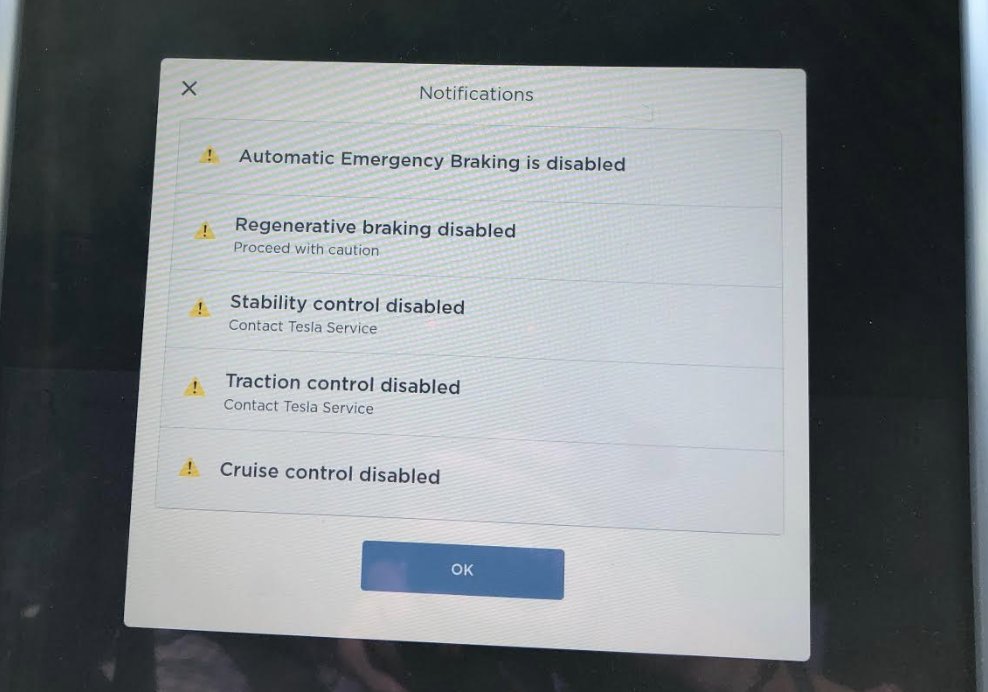
And that brings us to the tow truck photo at the top of the article. We were near Myrtle Beach and decided to try an early bird special at one of our favorite (and very busy) restaurants. The restaurant sits on Murrells Inlet with a narrow road behind it with perpendicular parking spots. As we pulled into the driveway and positioned the car to back into a parking space, we got alarms that over a dozen systems in the vehicle had failed. In addition to the notifications shown above on the main console, the Tesla’s dashboard lights looked like you’d hit the million dollar jackpot: flat tire light, brake failure, parking brake locked, and many more. Worse yet, we were sitting in the middle of the road with a vehicle stuck in reverse that wouldn’t move. To add insult to injury, a little old lady driving her car with a handicap sign is shaking her fist complaining that we’re blocking the road. Fun times. We got out of the car to call Tesla thinking that exiting the vehicle might shut down the vehicle. Wrong again. It locked all of the doors and even Tesla’s whiz kids in California couldn’t unlock them. Luckily, within about 10 minutes, the car magically unlocked, and we were able to pull into a parking spot and place the car in park. To its credit, Tesla paid to tow the car 200+ miles to Charlotte, paid for an Uber ride back to our house, and paid for a rental car… for the next three weeks that it took to diagnose the problem with the car. It turned out to be a bent pin on the master control unit that had been replaced several months before. Will that happen to you and your Tesla? Probably not. But it reinforces how precarious the maintenance situation is with Tesla vehicles. We sold the car with a clean bill of health the same day it was available for pickup from the Charlotte Service Center. The buyer actually met us at the service center and got to hear the repair story first hand. What we found most troubling was the lack of adequate diagnostic tools to identify a problem of this severity on a $140,000 vehicle. While it turned out to be a simple fix, it didn’t make you want to buy a round-trip ticket on one of Elon’s adventures to Mars. Would we buy another Tesla? Not without a local service center.
So What’s Next? Here’s a Sneak Peek…
Continue reading the Tesla saga…
The Autonomous Car: Tesla & The Winding Road (January 9, 2017)
The Autonomous Car: A Hands-Free Drive with Tesla’s HW2 (January 23, 2017)
The Autonomous Car: Navigating Tesla’s Slippery Slope to the Promised Land (3/13/2017)
The Autonomous Car: Move Over Tesla, Here Comes Cadillac (April 17, 2017)
The Autonomous Car: Move Over Tesla, Here Comes Everybody (April 28, 2018)
Originally published: Thursday, November 8, 2018
Special Thanks to Our Generous Sponsors
FULL DISCLOSURE: ClearlyIP, Skyetel, Vitelity, DigitalOcean, Vultr, VoIP.ms, 3CX, Sangoma, TelecomsXchange and VitalPBX have provided financial support to Nerd Vittles and our open source projects through advertising, referral revenue, and/or merchandise. As an Amazon Associate and Best Buy Affiliate, we also earn from qualifying purchases. We’ve chosen these providers not the other way around. Our decisions are based upon their corporate reputation and the quality of their offerings and pricing. Our recommendations regarding technology are reached without regard to financial compensation except in situations in which comparable products at comparable pricing are available from multiple sources. In this limited case, we support our sponsors because our sponsors support us.
 BOGO Bonaza: Enjoy state-of-the-art VoIP service with a $10 credit and half-price SIP service on up to $500 of Skyetel trunking with free number porting when you fund your Skyetel account. No limits on number of simultaneous calls. Quadruple data center redundancy. $25 monthly minimum spend required. Tutorial and sign up details are here.
BOGO Bonaza: Enjoy state-of-the-art VoIP service with a $10 credit and half-price SIP service on up to $500 of Skyetel trunking with free number porting when you fund your Skyetel account. No limits on number of simultaneous calls. Quadruple data center redundancy. $25 monthly minimum spend required. Tutorial and sign up details are here.
 The lynchpin of Incredible PBX 2020 and beyond is ClearlyIP components which bring management of FreePBX modules and SIP phone integration to a level never before available with any other Asterisk distribution. And now you can configure and reconfigure your new Incredible PBX phones from the convenience of the Incredible PBX GUI.
The lynchpin of Incredible PBX 2020 and beyond is ClearlyIP components which bring management of FreePBX modules and SIP phone integration to a level never before available with any other Asterisk distribution. And now you can configure and reconfigure your new Incredible PBX phones from the convenience of the Incredible PBX GUI.
 VitalPBX is perhaps the fastest-growing PBX offering based upon Asterisk with an installed presence in more than 100 countries worldwide. VitalPBX has generously provided a customized White Label version of Incredible PBX tailored for use with all Incredible PBX and VitalPBX custom applications. Follow this link for a free test drive!
VitalPBX is perhaps the fastest-growing PBX offering based upon Asterisk with an installed presence in more than 100 countries worldwide. VitalPBX has generously provided a customized White Label version of Incredible PBX tailored for use with all Incredible PBX and VitalPBX custom applications. Follow this link for a free test drive!
 Special Thanks to Vitelity. Vitelity is now Voyant Communications and has halted new registrations for the time being. Our special thanks to Vitelity for their unwavering financial support over many years and to the many Nerd Vittles readers who continue to enjoy the benefits of their service offerings. We will keep everyone posted on further developments.
Special Thanks to Vitelity. Vitelity is now Voyant Communications and has halted new registrations for the time being. Our special thanks to Vitelity for their unwavering financial support over many years and to the many Nerd Vittles readers who continue to enjoy the benefits of their service offerings. We will keep everyone posted on further developments.

Autonomous Cars: Move Over Tesla, Here Comes Everybody
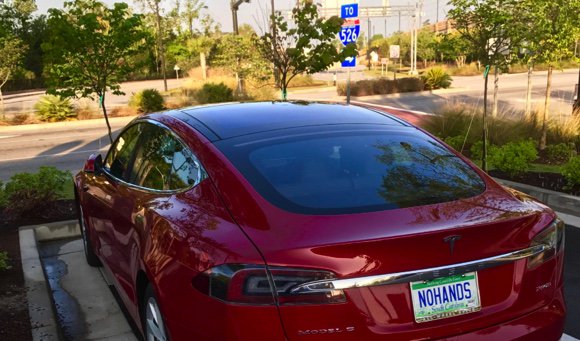
It’s been about a year since our last Tesla® report card. And, wow, how the landscape has changed. For most of the year, Tesla has stumbled and bumbled through about a dozen updates. With each one, Tesla’s resident cheerleader, Electrek, has proclaimed that self-driving autonomy was "just around the corner." We’re still waiting although we’re writing this only because last month’s update finally achieved the milestone of being able to navigate the interstate highway in our own hometown without darting into another lane of traffic. In other news, Tesla lost its third head of the AutoPilot project in less than a year. Yet, in 2018, Tesla’s Model S continues to rank as the #1 selling luxury car worldwide by a large margin despite being awarded an "F" by the Better Business Bureau.
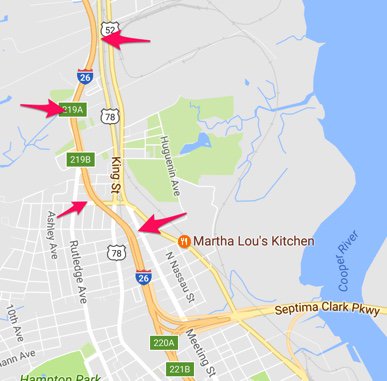
While things may have improved in our hometown, that was not the case in California where a Tesla had a romantic encounter with the back end of a fire truck and another driver recently was killed while using AutoPilot when his car rammed into a barrier. Not to be outdone, another Tesla owner decided to recreate the event and almost suffered the same fate. See video below. Despite the accidents, Elon Musk continues to assert that Tesla vehicles are safer than any other cars on the road. That assertion now has been refuted by the NHTSA, and this Ars Technica article explains why.
In the meantime, autonomous driving has spread to a whole host of other companies. Uber was going great guns with their self-driving vehicles until one of their vehicles killed a pedestrian last month with an Uber driver reportedly sitting behind the wheel. On the General Motors front, the 2018 Cadillac CT6 introduced SuperCruise which performs hands-free driving on interstate highways in the U.S. as long as the driver keeps his or her eyes on the road. As CNBC opined, "If General Motors deploys it to other vehicles besides the CT6 it could instantly become the unrivaled leader in semi-autonomy."
You may recall that Tesla originally used Mobileye® technology for its AutoPilot offering until the two companies parted ways after a driver was blindsided by an 18-wheeler and killed. Each company blamed the other, but it seems fair to conclude that Elon Musk overhyped the capabilities of AutoPilot, and that made Mobileye nervous because their technology at the time was clearly not capable of performing the feats that Elon was touting. Subsequently, Intel® acquired Mobileye in a deal valued at over $15 billion.
UPDATE: Tesla now has admitted it overhyped AutoPilot in a proposed $5 million settlement of a class action lawsuit. Details here.
Mobileye hasn’t stood still. With over 15 years of development work behind its EyeQ® software-on-chip (SoC), it now provides the "brains" for Audi’s new A8 Traffic Jam Pilot and Nissan’s ProPilot Assist in the latest Leaf and Rogue vehicles. EyeQ interprets raw data from a forward-facing camera, enabling vehicles to "see" the road and objects ahead, and plot a safe path forward. In contrast to GM’s HD mapping approach, both Tesla’s AutoPilot and Mobileye’s EyeQ SOC could best be described as follow-the-dotted-line technology.
https://youtu.be/rnke9JkPfUI
Nissan’s self-driving technology with EyeQ has barely been mentioned in the automotive reviews of Nissan’s new 2018 vehicles even though the technology press, except Electrek, had promising reviews. We were especially curious about the two Nissan vehicles and went for test drives in both of them. Suffice it to say, we were so impressed that we now own a 2018 Nissan Rogue, and we can provide a first-hand comparison to our Tesla whose price tag was roughly quadruple that of the Rogue. Comparing interiors, you would think the price tags should be the other way around. My family would be the first to tell you that what’s missing is a hood ornament that says Mercedes or BMW. Aside from that, for all-around use, the Nissan Rogue is our 2018 Car of the Year by any objective measure. If you’re looking for an in-town vehicle for daily commuting, the new Nissan Leaf fits the bill perfectly although the lack of a suitable charging network in many areas makes all-purpose use difficult with the 150-mile range limitation. Next year’s model with a range of 225 miles could be a different story. It took Tesla 15 months to navigate the I-26 curves in self-driving mode. The Rogue and Leaf did it on the first day out of the showroom. There’s more.
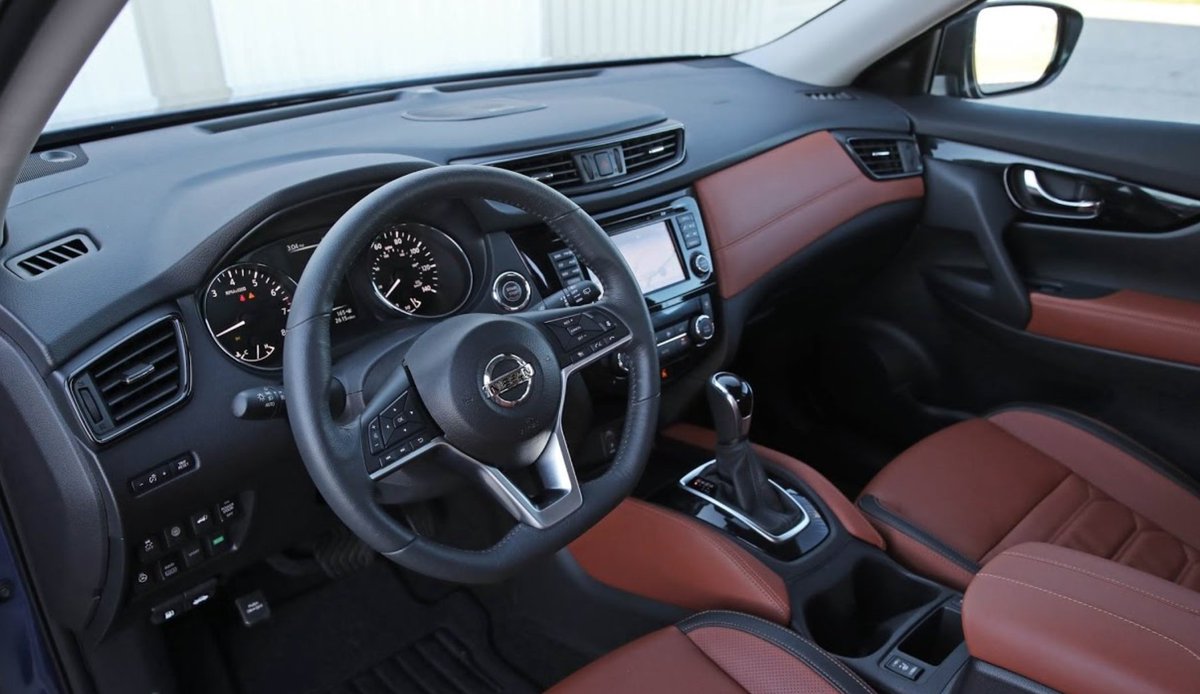
Tesla and Nissan have taken two very different approaches to autonomous driving. With Tesla’s AutoPilot, it’s an all-or-nothing deal. Either AutoPilot is steering or you are, but never both. With Nissan’s ProPilot Assist, it’s much like the Driver’s Ed car with two steering wheels. Either you or ProPilot can make steering adjustments without disabling ProPilot. When you switch lanes on a city street in AutoPilot mode on the Tesla, you physically have to wrestle the steering wheel away from AutoPilot, and the AP2 functionality then is permanently disabled until you manually reenable it. On the Rogue, you change lanes and make steering adjustments just as you would in any other car with no noticeable resistance from the ProPilot Assist hardware. The Rogue only disables ProPilot if it loses lane markings. Once it again identifies clear lane markings, it automatically reengages and you continue on your way. Having used both systems, anyone would conclude that the Nissan approach is better for a couple of reasons: it’s more intuitive in emulating what ordinary drivers do on the road and it’s fully automatic as a driver assistance tool.
The Tesla still has an advantage on poorly marked roads. In addition to following the dotted lines, the Tesla will also track a vehicle in front of you without disabling autopilot. ProPilot Assist can’t do that and will issue a chime when it disables self-driving mode. But, as noted earlier, when ProPilot Assist can once again identify clear lane markings, it will reengage automatically. In contrast, when the Tesla loses tracking and beeps to alert you that autopilot has been disabled, it remains disabled until you watch the dash for an indication that the Tesla has once again identified clear lane markings. Then you have to manually reenable it. Especially on many city streets, this is a regular occurrence so our tip of the hat again goes to the Nissan approach.
Do yourself a favor and go test drive one of the new Nissan vehicles equipped with ProPilot Assist. We’re betting you’ll drive home with a new vehicle. And, if you really want to spruce up your new vehicle, check out the new $50 Amazon Alexa offering from Anker. It’s awesome!

We’ll leave you with a sneak peek at some of our favorites from the Cars on Kiawah show last weekend. Just click on the image below to open the slide show.
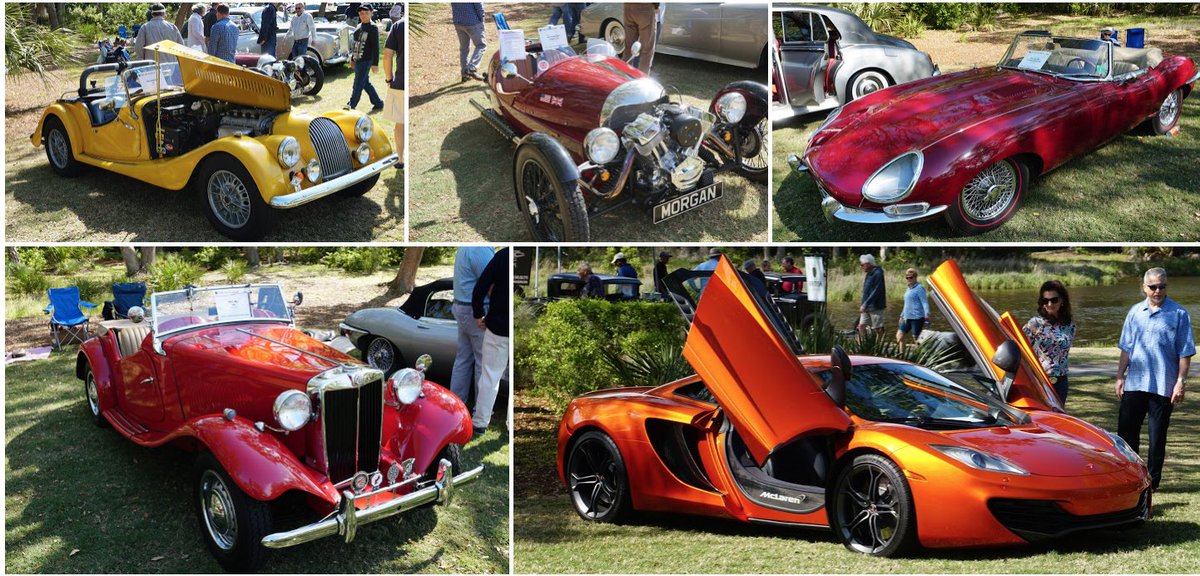
Originally published: Saturday, April 28, 2018
Got Friends? 7 Countries Have Never Visited Nerd Vittles. 2018 Is Calling! https://t.co/wMfmlhAr16 #asterisk #freepbx #wazo #issabel #IncrediblePBX #3CX pic.twitter.com/kAmAEnwVIw
— Ward Mundy (@NerdUno) January 9, 2018
Special Thanks to Our Generous Sponsors
FULL DISCLOSURE: ClearlyIP, Skyetel, Vitelity, DigitalOcean, Vultr, VoIP.ms, 3CX, Sangoma, TelecomsXchange and VitalPBX have provided financial support to Nerd Vittles and our open source projects through advertising, referral revenue, and/or merchandise. As an Amazon Associate and Best Buy Affiliate, we also earn from qualifying purchases. We’ve chosen these providers not the other way around. Our decisions are based upon their corporate reputation and the quality of their offerings and pricing. Our recommendations regarding technology are reached without regard to financial compensation except in situations in which comparable products at comparable pricing are available from multiple sources. In this limited case, we support our sponsors because our sponsors support us.
 BOGO Bonaza: Enjoy state-of-the-art VoIP service with a $10 credit and half-price SIP service on up to $500 of Skyetel trunking with free number porting when you fund your Skyetel account. No limits on number of simultaneous calls. Quadruple data center redundancy. $25 monthly minimum spend required. Tutorial and sign up details are here.
BOGO Bonaza: Enjoy state-of-the-art VoIP service with a $10 credit and half-price SIP service on up to $500 of Skyetel trunking with free number porting when you fund your Skyetel account. No limits on number of simultaneous calls. Quadruple data center redundancy. $25 monthly minimum spend required. Tutorial and sign up details are here.
 The lynchpin of Incredible PBX 2020 and beyond is ClearlyIP components which bring management of FreePBX modules and SIP phone integration to a level never before available with any other Asterisk distribution. And now you can configure and reconfigure your new Incredible PBX phones from the convenience of the Incredible PBX GUI.
The lynchpin of Incredible PBX 2020 and beyond is ClearlyIP components which bring management of FreePBX modules and SIP phone integration to a level never before available with any other Asterisk distribution. And now you can configure and reconfigure your new Incredible PBX phones from the convenience of the Incredible PBX GUI.
 VitalPBX is perhaps the fastest-growing PBX offering based upon Asterisk with an installed presence in more than 100 countries worldwide. VitalPBX has generously provided a customized White Label version of Incredible PBX tailored for use with all Incredible PBX and VitalPBX custom applications. Follow this link for a free test drive!
VitalPBX is perhaps the fastest-growing PBX offering based upon Asterisk with an installed presence in more than 100 countries worldwide. VitalPBX has generously provided a customized White Label version of Incredible PBX tailored for use with all Incredible PBX and VitalPBX custom applications. Follow this link for a free test drive!
 Special Thanks to Vitelity. Vitelity is now Voyant Communications and has halted new registrations for the time being. Our special thanks to Vitelity for their unwavering financial support over many years and to the many Nerd Vittles readers who continue to enjoy the benefits of their service offerings. We will keep everyone posted on further developments.
Special Thanks to Vitelity. Vitelity is now Voyant Communications and has halted new registrations for the time being. Our special thanks to Vitelity for their unwavering financial support over many years and to the many Nerd Vittles readers who continue to enjoy the benefits of their service offerings. We will keep everyone posted on further developments.

The Autonomous Car: Tesla and the Yellow Brick Road

Today marks the six month anniversary since we picked up our second generation Tesla Model S. If you’ve followed our adventure, you already know that the road has been a bumpy one even giving Elon Musk credit for the best of intentions. As one new owner remarked, "The difference in a salesman and a marketer is the marketer knows he is lying." We haven’t quite decided which pigeon hole best describes Elon, but there certainly was optimistic puffing of the Tesla feature set to put it charitably. And the time to begin sale of Model 3’s is just around the corner with a half million people already waiting in line.
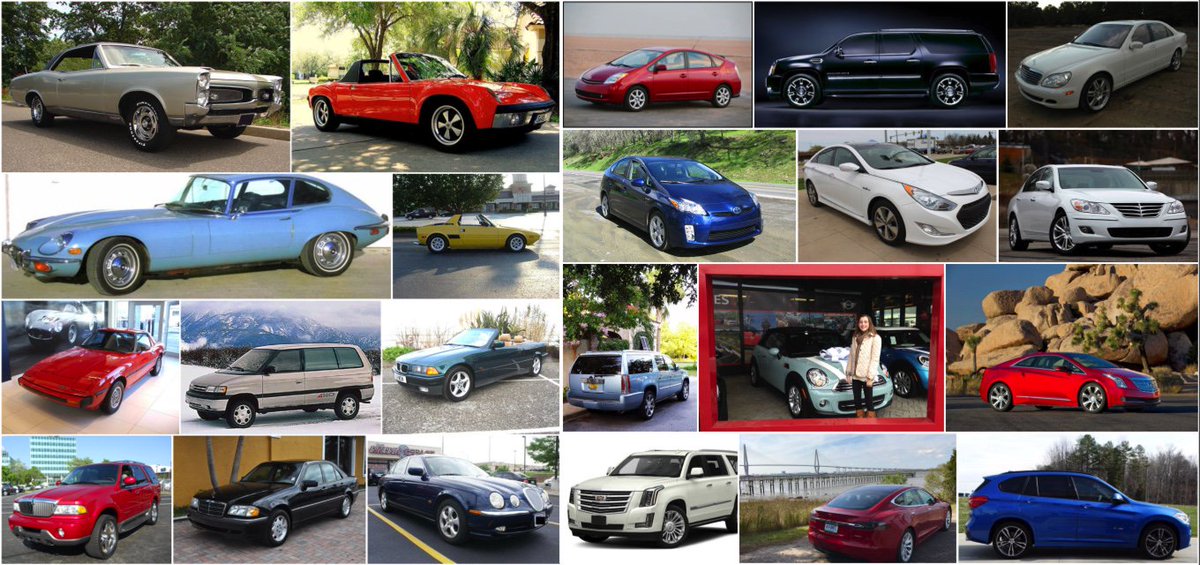
Having owned a couple dozen cars, we decided it might be a good opportunity to weigh the pro’s and con’s of buying a Tesla, any Tesla. On the plus side, receiving over-the-air software updates every month is one of the greatest advancements in the history of the automobile industry. A Tesla is essentially a supercomputer on wheels so these updates offer a monthly opportunity for Tesla to radically improve your driving experience… at no cost to you! Compare that to Cadillac which will give you a new GPS map once a year for about $300. Since we accepted delivery of the Tesla, the updates have added a five-range equalizer with Dolby Surround Sound, automatic emergency braking, side collision avoidance, auto-dimming headlights, self-parking, auto-summon for vehicle retrieval, and multiple upgrades to the traffic-aware cruise control and autopilot systems. During a 600-mile road trip to Atlanta, we stopped once in each direction for a 45-minute battery refill using Tesla’s free superchargers. By the way, they won’t be free to new owners unless you take advantage of an existing owner’s coupon to purchase a Model S or X at a $1,000 discount which also includes free lifetime usage of Tesla’s supercharger network. That saves you about ten cents per mile. Here’s our referral link if you need one. As with most referral links, we get something, too: a mini-Tesla for our new grandson. 🙂
And speaking of road trips, let us offer some tips on using Tesla’s Supercharger network. A one-hour charge will typically buy you about 150-200 miles depending upon the current state of your battery. If there are other Teslas at the site, be sure you choose a numbered supercharger that is different from the other vehicles. Otherwise, your charging rate is cut in half. Some locations are better than others, and we’ve pretty much covered the southeastern United States at this juncture. The Augusta, Georgia site is a 5-minute walk from Denny’s which makes it an excellent site around meal time if you’re heading east or west on I-20. For those traveling on I-85 or I-40 through North Carolina, the Burlington Supercharger is a definite must with a rich collection of restaurants as well as a terrific grocery store within one block. Charlotte and Greenville are pretty much in the middle of nowhere so pick up some fast food before you arrive if you plan to stay for an hour. The Atlanta Supercharger in the Level 2 garage of Atlantic Station downtown is a shopper’s paradise with dozens of shops and restaurants to keep you entertained. For those on the east coast heading south, there’s now a supercharger in Myrtle Beach at the Coastal Grand Mall which also provides lots of restaurants and shopping distractions. Another one is located in the Savannah, Georgia airport with two free hours of parking. The wrinkle is that there’s only one restaurant in the airport, and it’s lousy so bring food with you if you are stopping there for an extended charge. From Charleston, we typically do a restroom break there which takes about 20 minutes including the time to get on and off I-95. A 10-minute charge gets you about 55 extra miles. Then you can make it to the Kingsland, Georgia which is right at the Florida border with lots of restaurants within easy walking distance. From there, you can make it to St. Augustine, Florida where you’ll land right in the middle of all the "interstate hotels" with lots of fast food restaurants nearby. Another don’t miss site is Port Orange which has a large mall and lots of restaurants. From there you can easily make it to Orlando or Port St. Lucie. On our recent 1,100 mile trip to Virginia and Atlanta and our 900 mile trip to Florida, we saw a grand total of two other Teslas in all of the supercharger locations we used. That may change once the Model 3’s start rolling off the assembly line. We would estimate that we spent less than an hour at supercharger locations traveling in each direction. We typically try to stay at Hilton Hotels which have free overnight charging at many of their sites. Make a phone call to verify destination charging before booking. EVTripPlanner is also a handy web site when planning your travels. It includes most Superchargers and Destination Chargers and can show you the most convenient stops.
So that’s the good news. The rest of the story is mostly about Tesla’s marketing tactics. For us, they promised considerably more than they delivered when we received the car. That leaves a bad taste in your mouth for a very long time, particularly with vehicles costing $70,000 to $170,000. The disappointing part is that we would have bought the car even if Tesla had honestly described what was available with delivery and what could be expected down the road. Looking back, Tesla’s developments on the autopilot front have been nothing short of miraculous. Tesla has delivered in six months what it took Mobileye almost ten years to develop. That’s not to say it’s not still dangerous. It is. To the guy that chooses to drive with your hands off the wheel, make sure your affairs are in order and your will is up to date. And there are some other rough edges which are reported regularly. An owner last week posted that his headlights abruptly turned off in the middle of the night while he was cruising along at highway speeds. Should this happen to you, remember you can pull the turn signal stalk to instantly turn on your bright lights which will at least let you guide the car to a safe stop. Yet another reason to follow the Tesla Motors Forum should you buy a Tesla.
Will Tesla get there? I think so. But self-driving technology is still evolving, and it probably will be for the next several years. If you’re not in a hurry, you might consider waiting another year or two and compare other options. But, for now, Tesla is the only game in town, and it’s finally usable on most interstates and major thoroughfares. The other downside of a Tesla is service center locations. While we were lucky and received an almost perfect car, others have not been so lucky. If there’s not a service center close to you, that is a real problem. If you have a flat tire, there is no spare and that, too, can be problematic depending upon where you live. The good news is that AAA offers a plan for under $100 that includes free towing up to 200 miles once a year. If you travel a good bit, sign up!
Finally, a word about options. The S75 base model of the Model S is under $70,000 with federal tax credit. The Model X SUV is about $10,000 more. You can future-proof the cars for $8,000 to lock in full self-driving capability for down the road. For short road trips and in-town driving, the 249 mile range of the S75 is more than adequate. In most areas of the U.S., superchargers are located every 150 miles or less. Many of the Tesla showrooms now have new and used vehicles for immediate sale. The advantage is you can see what you’ll be getting before you spend a dime. Because of the pace of technology developments in both electric vehicles and self-driving technology, we would lease the vehicle if we had it to do over again. So what are you waiting for? Come join the party!
Continue reading…
The Autonomous Car: Tesla & The Winding Road (January 9, 2017)
The Autonomous Car: A Hands-Free Drive with Tesla’s HW2 (January 23, 2017)
The Autonomous Car: Navigating Tesla’s Slippery Slope to the Promised Land (3/13/2017)
The Autonomous Car: Move Over Tesla, Here Comes Cadillac (April 17, 2017)
Published: Monday, June 19, 2017
Special Thanks to Our Generous Sponsors
FULL DISCLOSURE: ClearlyIP, Skyetel, Vitelity, DigitalOcean, Vultr, VoIP.ms, 3CX, Sangoma, TelecomsXchange and VitalPBX have provided financial support to Nerd Vittles and our open source projects through advertising, referral revenue, and/or merchandise. As an Amazon Associate and Best Buy Affiliate, we also earn from qualifying purchases. We’ve chosen these providers not the other way around. Our decisions are based upon their corporate reputation and the quality of their offerings and pricing. Our recommendations regarding technology are reached without regard to financial compensation except in situations in which comparable products at comparable pricing are available from multiple sources. In this limited case, we support our sponsors because our sponsors support us.
 BOGO Bonaza: Enjoy state-of-the-art VoIP service with a $10 credit and half-price SIP service on up to $500 of Skyetel trunking with free number porting when you fund your Skyetel account. No limits on number of simultaneous calls. Quadruple data center redundancy. $25 monthly minimum spend required. Tutorial and sign up details are here.
BOGO Bonaza: Enjoy state-of-the-art VoIP service with a $10 credit and half-price SIP service on up to $500 of Skyetel trunking with free number porting when you fund your Skyetel account. No limits on number of simultaneous calls. Quadruple data center redundancy. $25 monthly minimum spend required. Tutorial and sign up details are here.
 The lynchpin of Incredible PBX 2020 and beyond is ClearlyIP components which bring management of FreePBX modules and SIP phone integration to a level never before available with any other Asterisk distribution. And now you can configure and reconfigure your new Incredible PBX phones from the convenience of the Incredible PBX GUI.
The lynchpin of Incredible PBX 2020 and beyond is ClearlyIP components which bring management of FreePBX modules and SIP phone integration to a level never before available with any other Asterisk distribution. And now you can configure and reconfigure your new Incredible PBX phones from the convenience of the Incredible PBX GUI.
 VitalPBX is perhaps the fastest-growing PBX offering based upon Asterisk with an installed presence in more than 100 countries worldwide. VitalPBX has generously provided a customized White Label version of Incredible PBX tailored for use with all Incredible PBX and VitalPBX custom applications. Follow this link for a free test drive!
VitalPBX is perhaps the fastest-growing PBX offering based upon Asterisk with an installed presence in more than 100 countries worldwide. VitalPBX has generously provided a customized White Label version of Incredible PBX tailored for use with all Incredible PBX and VitalPBX custom applications. Follow this link for a free test drive!
 Special Thanks to Vitelity. Vitelity is now Voyant Communications and has halted new registrations for the time being. Our special thanks to Vitelity for their unwavering financial support over many years and to the many Nerd Vittles readers who continue to enjoy the benefits of their service offerings. We will keep everyone posted on further developments.
Special Thanks to Vitelity. Vitelity is now Voyant Communications and has halted new registrations for the time being. Our special thanks to Vitelity for their unwavering financial support over many years and to the many Nerd Vittles readers who continue to enjoy the benefits of their service offerings. We will keep everyone posted on further developments.
Some Recent Nerd Vittles Articles of Interest…
The Autonomous Car: Move Over Tesla, Here Comes Cadillac

It’s been six months since Elon Musk announced the new Tesla HW2 models with what he proclaimed would be the world’s first fully autonomous, self-driving automobiles. And, guess what? Tesla is not perceptibly closer to a fully autonomous car today than they were six months ago. In fact, the last six months have been consumed playing catchup to the first generation Tesla with its Mobileye technology which Tesla quietly dropped while Intel spent $15.3 billion last month acquiring the company and its technology. In ditching Mobileye, Tesla basically threw the baby out with the bath water leaving them with fancy new autopilot hardware and no code. To make matters worse, their top two guys in the autonomous driving division abruptly left the company. And then along comes the Cadillac Easter Bunny last week to announce the fall availability of Super Cruise, a fully self-driving automobile for 160,000 miles of U.S. interstate highways.
Having just returned from an 1,100 mile Interstate journey through Florida in our four-month-old Tesla, I thought it might be helpful to document the progress that has been made toward realizing Elon’s "I Have a Dream" speech from last October in which he, too, promised a hands-free coast-to-coast drive in a Tesla by the end of 2017.
Spoiler Alert: Don’t be misled by our license plate. It’s not gonna happen this year!
If you’ve been following along in our Autonomous Car series of articles, you already know that there have been some hiccups in the Tesla saga. But there’s some good news today. Our Florida trip confirmed that Tesla vehicles with AutoPilot 2 technology are close to achieving parity with the first generation Tesla automobiles. That’s not to suggest that you would ever want to take your hands off the steering wheel unless you have a death wish. There were at least a half dozen incidents where your wish would have been realized during our trip. What is particularly disturbing is that Tesla apparently has made a conscious design decision to automatically turn off AP2 whenever it encounters a situation it can’t handle. One can only assume this has been done to afford the company deniability when you and your passengers are lying face down in a ditch somewhere because AP2 did something stupid while your car was barreling down the road at 70+ miles per hour. Your Tesla’s log would show that AP2 was not engaged at the moment of your untimely demise. Never mind that it might have caused it and then turned itself off. But keep in mind that Tesla has warned you not to take your hands off the wheel, and that’s what they’ll tell the jury. In the meantime, Cadillac will actually be deploying hands-free cars to its customers.
By design, AP2 is not a system that gives you even a second’s warning that your autonomous vehicle is about to come unglued. In fact, you get no warning other than a beep signifying that AP2 is no longer functioning. Meanwhile, cruise control takes over and keeps your Tesla zipping along at your previous AP2 speed regardless of the direction in which your Tesla may be headed. Tesla AP2 also has an uncanny ability to abruptly veer left whenever AP2 fails. Your only salvation is two hands firmly locking down the steering wheel to assure that the car can’t dart into another lane of traffic, a retaining wall, or a ditch on the side of the road. While we’d give the Tesla a solid A on 99% of our 1,100 mile adventure, that wouldn’t have been good enough to keep you out of the hospital or mortuary if you had elected to make the trip a hands-free adventure. You’ve been warned!
The good news is that we didn’t experience a single incident where the Tesla slammed on the brakes after detecting an overhead sign that it believed was sitting in the roadway. Nor did the Tesla try to take every interstate exit it passed. These were marked improvements from the first few months with AP2 when both were regular occurrences. The other good news is that, during 1,100 miles of use, we only encountered a handful of incidents where AP2 failed, and most of those were predictable if you were paying full attention to driving. Keep in mind that AP2 still cannot handle anything more complicated than a very minor curve in the highway, and there is little to no reliance upon map data in the current AP2 design. This is "follow-the-dotted-line" technology on straight roads, and nothing more. We’ve documented this on the I-26 interstate around Charleston where we live:
As this Google Map of the roadway makes clear, we are not talking about sharp curves in the highway. These are sections of interstate which do not even warrant a curve warning.

What’s still missing from the Tesla AP2 self-driving methodology is any reliance upon maps, cameras, radar, or sonar to detect or inhibit collisions with objects, merging vehicles, or vehicles traveling anywhere except directly in front of your vehicle. Watch the video above again and count the tenths of a second that elapsed between the time AP2 disengaged itself while the Tesla veered left until the car immediately beside us passes our Tesla in the left lane. You will note there was no driver alert of any kind that the car was there nor did our Tesla feel shy about veering directly into the other car’s path. We’ve documented the current state of AP2 development primarily to warn would-be Tesla drivers to be extremely careful. As we’ve noted before, drive a Tesla with AP2 enabled using the same care you would use if holding a toddler in your lap with their hands on your steering wheel. AP2 has roughly the same driving acumen as that toddler.
And that brings us to Cadillac and why last week’s announcement is especially newsworthy. Cadillac is poised to snatch the crown of the first truly self-driving vehicle from the hands of Tesla. Cadillac, like many other car manufacturers, is headed in a very different direction with autonomous driving. It’s roughly the same map-driven autonomous driving technology that Elon Musk demonstrated in his infamous Tesla self-driving video from last October. Make no mistake. The current Tesla AP2 design has no similarities to either the Cadillac technology shown above or the Tesla vaporware shown in the following video clip:
Maybe some day but, absent a miracle and not just a sales pitch, it won’t be this year for Tesla. In the meantime, Tesla is about to become part of a very crowded field. They will have not only Cadillac but also Mercedes, BMW, Audi, and the Japanese cars to contend with not to mention some add-on hardware from Google and perhaps Apple, Delphi, or perhaps a $999 add-on from George Hotz that will work with current generation vehicles. One thing’s for sure. It’s going to be exciting!
There is a silver lining to our Tesla story. We made the whole 1,100 mile journey at the same pace as any other automobile without spending a nickel on fuel of any kind. That in itself is quite a feat and a testament to Elon Musk’s EV vision. For those headed down I-95 to Florida in a Tesla, here are a few tips. The hands-down winner for Worst Supercharger goes to the Savannah, Georgia airport. Charging time was about 100 miles in an hour with a single (lousy & overpriced) restaurant inside the airport. You can get your parking pass stamped at the Information Desk in the terminal to get out of the airport for free. Don’t miss the Supercharger in Kingsland, Georgia and Malson’s BBQ. And no Supercharger can top the Port Orange, Florida specs of 300 miles in under an hour while dining at any of more than a dozen terrific restaurants. Positioned next to the Tesla superchargers in Port Orange was an RV exhibition with dozens of Class A (6-9 MPG) motorhomes including $400,000+ Winnebagos from LaMesaRV. And look whose Collision Avoidance System Winnebago is using. 🙂 Thanks, Philip Mascioli, for the great tour.

Published: Monday, April 17, 2017
BREAKING NEWS: Not the best week for Tesla…
Tesla recalls 53,000 autos to replace faulty parking brakes https://t.co/gQNMGPE2mN pic.twitter.com/Ir9q3jejNO
— Bloomberg (@business) April 20, 2017
Tesla customers sue over "dangerous" and non-functioning autopilot software https://t.co/Z0T7tZEujh pic.twitter.com/3HeRk6X8X6
— Forbes Tech (@ForbesTech) April 20, 2017
Special Thanks to Our Generous Sponsors
FULL DISCLOSURE: ClearlyIP, Skyetel, Vitelity, DigitalOcean, Vultr, VoIP.ms, 3CX, Sangoma, TelecomsXchange and VitalPBX have provided financial support to Nerd Vittles and our open source projects through advertising, referral revenue, and/or merchandise. As an Amazon Associate and Best Buy Affiliate, we also earn from qualifying purchases. We’ve chosen these providers not the other way around. Our decisions are based upon their corporate reputation and the quality of their offerings and pricing. Our recommendations regarding technology are reached without regard to financial compensation except in situations in which comparable products at comparable pricing are available from multiple sources. In this limited case, we support our sponsors because our sponsors support us.
 BOGO Bonaza: Enjoy state-of-the-art VoIP service with a $10 credit and half-price SIP service on up to $500 of Skyetel trunking with free number porting when you fund your Skyetel account. No limits on number of simultaneous calls. Quadruple data center redundancy. $25 monthly minimum spend required. Tutorial and sign up details are here.
BOGO Bonaza: Enjoy state-of-the-art VoIP service with a $10 credit and half-price SIP service on up to $500 of Skyetel trunking with free number porting when you fund your Skyetel account. No limits on number of simultaneous calls. Quadruple data center redundancy. $25 monthly minimum spend required. Tutorial and sign up details are here.
 The lynchpin of Incredible PBX 2020 and beyond is ClearlyIP components which bring management of FreePBX modules and SIP phone integration to a level never before available with any other Asterisk distribution. And now you can configure and reconfigure your new Incredible PBX phones from the convenience of the Incredible PBX GUI.
The lynchpin of Incredible PBX 2020 and beyond is ClearlyIP components which bring management of FreePBX modules and SIP phone integration to a level never before available with any other Asterisk distribution. And now you can configure and reconfigure your new Incredible PBX phones from the convenience of the Incredible PBX GUI.
 VitalPBX is perhaps the fastest-growing PBX offering based upon Asterisk with an installed presence in more than 100 countries worldwide. VitalPBX has generously provided a customized White Label version of Incredible PBX tailored for use with all Incredible PBX and VitalPBX custom applications. Follow this link for a free test drive!
VitalPBX is perhaps the fastest-growing PBX offering based upon Asterisk with an installed presence in more than 100 countries worldwide. VitalPBX has generously provided a customized White Label version of Incredible PBX tailored for use with all Incredible PBX and VitalPBX custom applications. Follow this link for a free test drive!
 Special Thanks to Vitelity. Vitelity is now Voyant Communications and has halted new registrations for the time being. Our special thanks to Vitelity for their unwavering financial support over many years and to the many Nerd Vittles readers who continue to enjoy the benefits of their service offerings. We will keep everyone posted on further developments.
Special Thanks to Vitelity. Vitelity is now Voyant Communications and has halted new registrations for the time being. Our special thanks to Vitelity for their unwavering financial support over many years and to the many Nerd Vittles readers who continue to enjoy the benefits of their service offerings. We will keep everyone posted on further developments.
Some Recent Nerd Vittles Articles of Interest…


 JUST RELEASED: Visit the Incredible PBX Wiki
JUST RELEASED: Visit the Incredible PBX Wiki